*NURSING > QUESTIONS & ANSWERS > HESI EXIT RN EXAM-756 Questions with accurate answers, HESI EXIT RN Exam (Version 1 to Version 7) HE (All)
HESI EXIT RN EXAM-756 Questions with accurate answers, HESI EXIT RN Exam (Version 1 to Version 7) HESI EXIT RN Exam V1-V7, 100% proven pass rate. Latest updates.
Document Content and Description Below
HESI EXIT RN EXAM-756 Questions with accurate answers, HESI EXIT RN Exam (Version 1 to Version 7) HESI EXIT RN Exam V1-V7, 100% proven pass rate. Latest updates. 1. Following discharge teachin... g, a male client with duodenal ulcer tells the nurse the he will drink plenty of dairy products, such as milk, to help coat and protect his ulcer. What is the best follow-up action by the nurse? a- Remind the client that it is also important to switch to decaffeinated coffee and tea. b- Suggest that the client also plan to eat frequent small meals to reduce discomfort c- Review with the client the need to avoid foods that are rich in milk and cream. d- Reinforce this teaching by asking the client to list a dairy food that he might select. Rationale: Diets rich in milk and cream stimulate gastric acid secretion and should be avoided. 2. A male client with hypertension, who received new antihypertensive prescriptions at his last visit returns to the clinic two weeks later to evaluate his blood pressure (BP). His BP is 158/106 and he admits that he has not been taking the prescribed medication because the drugs make him “feel bad”. In explaining the need for hypertension control, the nurse should stress that an elevated BP places the client at risk for which pathophysiological condition? a- Blindness secondary to cataracts b- Acute kidney injury due to glomerular damage c- Stroke secondary to hemorrhage d- Heart block due to myocardial damage Rationale: Stroke related to cerebral hemorrhage is major risk for uncontrolled hypertension. 3. The nurse observes an unlicensed assistive personnel (UAP) positioning a newly admitted client who has a seizure disorder. The client is supine and the UAP is placing soft pillows along the side rails. What action should the nurse implement? a- Ensure that the UAP has placed the pillows effectively to protect the client. b- Instruct the UAP to obtain soft blankets to secure to the side rails instead of pillows. a- Assume responsibility for placing the pillows while the UAP completes another task. b- Ask the UAP to use some of the pillows to prop the client in a side lying position. Rationale: The nurse should instruct the UAP to pad the side rails with soft blankest because the use of pillows could result in suffocation and would need to be removed at the onset of the seizure. The nurse can delegate paddling the side rails to the UAP 4. An adolescent with major depressive disorder has been taking duloxetine (Cymbalta) for the past 12 days. Which assessment finding requires immediate follow-up? a- Describes life without purpose b- Complains of nausea and loss of appetite c- States is often fatigued and drowsy d- Exhibits an increase in sweating. Rationale: Cymbalta is a selective serotonin and norepinephrine reuptake inhibitor that is known to increase the risk of suicidal thinking in adolescents and young adults with major depressive disorder. B, C and D are side effects 5. A 60-year-old female client with a positive family history of ovarian cancer has developed an abdominal mass and is being evaluated for possible ovarian cancer. Her Papanicolau (Pap) smear results are negative. What information should the nurse include in the client’s teaching plan? a- Further evaluation involving surgery may be needed b- A pelvic exam is also needed before cancer is ruled out c- Pap smear evaluation should be continued every six month d- One additional negative pap smear in six months is needed. Rationale: An abdominal mass in a client with a family history for ovarian cancer should be evaluated carefully 6. A client who recently underwear a tracheostomy is being prepared for discharge to home. Which instructions is most important for the nurse to include in the discharge plan? a- Explain how to use communication tools. b- Teach tracheal suctioning techniques c- Encourage self-care and independence. d- Demonstrate how to clean tracheostomy site. Rationale: Suctioning helps to clear secretions and maintain an open airway, which is critical. 7. In assessing an adult client with a partial rebreather mask, the nurse notes that the oxygen reservoir bag does not deflate completely during inspiration and the client’s respiratory rate is 14 breaths / minute. What action should the nurse implement? a- Encourage the client to take deep breaths b- Remove the mask to deflate the bag c- Increase the liter flow of oxygen d- Document the assessment data Rational: reservoir bag should not deflate completely during inspiration and the client’s respiratory rate is within normal limits. 8. During a home visit, the nurse observed an elderly client with diabetes slip and fall. What action should the nurse take first? a- Give the client 4 ounces of orange juice b- Call 911 to summon emergency assistance c- Check the client for lacerations or fractures d- Asses clients blood sugar level Rationale: After the client falls, the nurse should immediately assess for the possibility of injuries and provide first aid as needed 9. At 0600 while admitting a woman for a schedule repeat cesarean section (C-Section), the client tells the nurse that she drank a cup a coffee at 0400 because she wanted to avoid getting a headache. Which action should the nurse take first? a- Ensure preoperative lab results are available b- Start prescribed IV with lactated Ringer’s c- Inform the anesthesia care provider d- Contact the client’s obstetrician. Rationale: Surgical preoperative instruction includes NPO after midnight the day of surgery to decrease the risk of aspiration should vomiting occur during anesthesia. While it is possible the C-section will be done on schedule or rescheduled for later in the day, the anesthesia provider should be notified first. 10. After placing a stethoscope as seen in the picture, the nurse auscultates S1 and S2 heart sounds. To determine if an S3 heart sound is present, what action should the nurse take first? a- Side the stethoscope across the sternum. b- Move the stethoscope to the mitral site c- Listen with the bell at the same location d- Observe the cardiac telemetry monitor Rationale: The nurse uses the bell of the stethoscope to hear low-pitched sounds such as S3 and S4. The nurse listens at the same site using the diaphragm the diaphragm and bell before moving systematically to the next sites. 11. A 66-year-old woman is retiring and will no longer have a health insurance through her place of employment. Which agency should the client be referred to by the employee health nurse for health insurance needs? a- Woman, Infant, and Children program b- Medicaid c- Medicare d- Consolidated Omnibus Budget Reconciliation Act provision. Rationale: Title XVII of the social security Act of 1965 created Medicare Program to provide medical insurance for person more than 65 years or older, disable or with permeant kidney failure, WIC provides supplemental nutrition to meet the needs of pregnant of breastfeeding woman, infants and children up to age of 6. Medicaid provides financial assistance to pay for medical services for poor older adults, blind, disable and families with dependent children. COBRA(D) health benefit provisions is a limited insurance plan for those who has been laid off or become unemployed. 12. A client who is taking an oral dose of a tetracycline complains of gastrointestinal upset. What snack should the nurse instruct the client to take with the tetracycline? a- Fruit-flavored yogurt. b- Cheese and crackers. c- Cold cereal with skim milk. d- Toasted wheat bread and jelly Rationale: Dairy products decrease the effect of tetracycline, so the nurse instructs the client to eat a snack such as toast, which contains no dairy products and may decrease GI symptoms. 13. Following a lumbar puncture, a client voices several complaints. What complaint indicated to the nurse that the client is experiencing a complication? a- “I am having pain in my lower back when I move my legs” b- “My throat hurts when I swallow” c- “I feel sick to my stomach and am going to throw up” d- I have a headache that gets worse when I sit up” Rationale: A post-lumbar puncture headache, ranging from mild to severe, may occur as a result of leakage of cerebrospinal fluid at the puncture site. This complication is usually managed by bedrest, analgesic, and hydration. 14. An elderly client seems confused and reports the onset of nausea, dysuria, and urgency with incontinence. Which action should the nurse implement? a- Auscultate for renal bruits b- Obtain a clean catch mid-stream specimen c- Use a dipstick to measure for urinary ketone d- Begin to strain the client’s urine. Rationale: This elderly is experiencing symptoms of urinary tract infection. The nurse should obtain a clean catch mid-stream specimen to determine the causative agent so an anti-infective agent can be prescribed. 15. The nurse is assisting the mother of a child with phenylketonuria (PKU) to select foods that are in keeping with the child’s dietary restrictions. Which foods are contraindicated for this child? a- Wheat products b- Foods sweetened with aspartame. c- High fat foods d- High calories foods. Rationale: Aspartame should not be consumed by a child with PKU because ut is converted to phenylalanine in the body. Additionally, milk and milk products are contraindicated for children with PKU. 16. Before preparing a client for the first surgical case of the day, a part-time scrub nurse asks the circulating nurse if a 3-minute surgical hand scrub is adequate preparation for this client. Which response should the circulating nurse provide? a- Ask a more experience nurse to perform that scrub since it is the first time of the day b- Validate the nurse is implementing the OR policy for surgical hand scrub c- Inform the nurse that hand scrubs should be 3 minutes between cases. d- Direct the nurse to continue the surgical hand scrub for a 5- minute duration. Rationale: The surgical hand scrub should last for 5 to 10 mints, so the nurse should be directed to continue the vigorous scrub using a reliable agent for the total duration of 5 mints. It is not necessary to reassign staff (A). The length of the hand scrub and subsequent scrubs during the day require the same process for the same amount of time, (B and C) 17. Which breakfast selection indicates that the client understands the nurse’s instructions about the dietary management of osteoporosis? a- Egg whites, toast and coffee. b- Bran muffin, mixed fruits, and orange juice. c- Granola and grapefruit juice d- Bagel with jelly and skim milk. Rationale: D includes dairy products which contain calcium and does not include any foods that inhibit calcium absorption. The primary dietary implication of osteoporosis is the need for increased calcium and reduction in foods that decrease calcium absorption, such as caffeine and excessive fiber. 18. The charge nurse of a critical care unit is informed at the beginning of the shift that less than the optimal number of registered nurses will be working that shift. In planning assignments, which client should receive the most care hours by a registered nurse (RN)? a- A 34-year -old admitted today after an emergency appendendectomy who has a peripheral intravenous catheter and a Foley catheter. b- A 48-year-old marathon runner with a central venous catheter who is experiencing nausea and vomiting due to electrolyte disturbance following a race. c- A 63-year-old chain smoker admitted with chronic bronchitis who is receiving oxygen via nasal cannula and has a saline-locked peripheral intravenous catheter. d- An 82-year-old client with Alzheimer’s disease newly-fractures femur who has a Foley catheter and soft wrist restrains applied Rationale: (D) describe the client at the most risk for injury and complications because of the factor listed. (A) has complete the recovery period form anesthesia but requires critical care because of the invasive lines and new abdominal incision. (B) is likely to be in excellent physical condition and has one invasive line needed for rehydration. (C) is essentially stable, despite having a chronic condition. 19. Z a- Cleanse the foot with soap and water and apply an antibiotic ointment b- Provide teaching about the need for a tetanus booster within the next 72 hours. c- have the mother check the child's temperature q4h for the next 24 hours d- transfer the child to the emergency department to receive a gamma globulin injection Rationale: The nurse should cleanse the wound first and implement B next. 20. The mother of an adolescent tells the clinic nurse, “My son has athlete’s foot, I have been applying triple antibiotic ointment for two days, but there has been no improvement.” What instruction should the nurse provide? a- Antibiotics take two weeks to become effective against infections such as athlete’s foot. b- Continue using the ointment for a full week, even after the symptoms disappear. c- Applying too much ointment can deter its effectiveness. Apply a thin layer to prevent maceration. d- Stop using the ointment and encourage complete drying of the feet and wearing clean socks. Rationale: Athlete’s foot (tinea pedi) is a fungal infection that afflicts the feet and causes scaliness and cracking of the skin between the toes and on the soles of the feet. The feet should be ventilated, dried well after bathing, and clean socks should be placed on the feet after bathing. Antifungal ointments may be prescribed, but antibiotic ointments are not useful. 21. A 26-year-old female client is admitted to the hospital for treatment of a simple goiter, and levothyroxine sodium (Synthroid) is prescribed. Which symptoms indicate to the nurse that the prescribed dosage is too high for this client? The client experiences a- Palpitations and shortness of breath b- Bradycardia and constipation c- Lethargy and lack of appetite d- Muscle cramping and dry, flushed skin Rationale: An overdose of thyroid preparation generally manifests symptoms of an agitated state such as tremors, palpitations, shortness of breath, tachycardia, increased appetite, agitation, sweating and diarrhea. 22. A client with a history of heart failure presents to the clinic with a nausea, vomiting, yellow vision and palpitations. Which finding is most important for the nurse to assess to the client? a- Determine the client’s level of orientation and cognition b- Assess distal pulses and signs of peripheral edema c- Obtain a list of medications taken for cardiac history. d- Ask the client about exposure to environmental heat. Rationale: The client is presenting with signs of digitalis toxicity. A list of medication, which is likely to include digoxin (Lanoxin) for heart failure, can direct further assessment in validating digitalis toxicity with serum labels greater than 2 mg/ml that is contributing to client’s presenting clinical picture. 23. The healthcare provider prescribes an IV solution of isoproterenol (Isuprel) 1 mg in 250 ml of D5W at 300 mcg/hour. The nurse should program the infusion pump to deliver how many ml/hour? (Enter numeric value only.) a- 75 Rationale: Convert mg to mcg and use the formula D/H x Q. 300 mcg/hour / 1,000 mcg x 250 ml = 3/1 x 25 = 75 ml/hour 24. The pathophysiological mechanisms are responsible for ascites related to liver failure? (Select all that apply) a- Bleeding that results from a decreased production of the body’s clotting factors b- Fluid shifts from intravascular to interstitial area due to decreased serum protein c- Increased hydrostatic pressure in portal circulation increases fluid shifts into abdomen d- Increased circulating aldosterone levels that increase sodium and water retention e- Decreased absorption of fatty acids in the duodenum leading to abdominal distention. Rationale: When liver fail production of albumin is reduced. Since albumin is the primary serum protein creating intravascular osmotic pressure, decreased serum protein allows a fluids shift into the interstitial space. Pressure increases in the portal circulation © when venous return from the upper GI tract cannot flow freely into sclerosed liver, which cause a pressure gradient to further Increase fluid shifts into the abdomen. A failing liver ineffectively inactivates steroidal hormones, such as aldosterone resulting in sodium and water retention. 25. The nurse is auscultating a client’s heart sounds. Which description should the nurse use to document this sound? (Please listen to the audio first to select the option that applies) a- S1 S2 b- S1 S2 S3 c- Murmur d- Pericardial friction rub. Rationale: A murmur is auscultated as a swishing sound that is associated with the blood turbulence created by the heart or valvular defect. B is associate with Heart Failure. 26. The healthcare provider prescribes celtazidime (Fortax) 35 mg every 8 hours IM for an infant. The 500 mg vial is labeled with the instruction to add 5.3 ml diluent to provide a concentration of 100 mg/ml. How many ml should the nurse administered for each dose? (Enter numeric value only. If rounding is required, round to the nearest tenth) a- 0.4 Rationale: 35mg/100mg x 1 = 0.35 = 0.4 ml 27. The nurse notes that a client has been receiving hydromorphone (Dilaudid) every six hours for four days. What assessment is most important for the nurse to complete? a- Auscultate the client's bowel sounds b- Observe for edema around the ankles c- Measure the client’s capillary glucose level d- Count the apical and radial pulses simultaneously Rationale: hydromorphone is a potent opioid analgesic that slows peristalsis and frequently causes constipation, so it is most important to Auscultate the client's bowel sounds 28. A female client is admitted with end stage pulmonary disease is alert, oriented, and complaining of shortness of breath. The client tells the nurse that she wants “no heroic measures” taken if she stops breathing, and she asks the nurse to document this in her medical record. What action should the nurse implement? a- Ask the client to discuss “do not resuscitate” with her healthcare provider 29. A client is receiving a full strength continuous enteral tube feeding at 50 ml/hour and has developed diarrhea. The client has a new prescription to change the feeding to half strength. What intervention should the nurse implement? a- Add equal amounts of water and feeding to a feeding bag and infuse at 50ml/hour b- Continue the full strength feeding after decreasing the rate of infusion to 25 ml/hr. c- Maintain the present feeding until diarrhea subsides and the begin the next new prescription. d- Withhold any further feeding until clarifying the prescription with healthcare provides. Rationale: Diluting the formula can help alleviate the diarrhea. Diarrhea can occur as a complication of enteral tube feeding and can be due to a variety of causes including hyperosmolar formula. 30. A female client reports that her hair is becoming coarse and breaking off, that the outer part of her eyebrows have disappeared, and that her eyes are all puffy. Which follow-up question is best for the nurse to ask? a- “Is there a history of female baldness in your family?” b- “Are you under any unusual stress at home or work?” c- “Do you work with hazardous chemicals?” d- “Have you noticed any changes in your fingernails?” Rationale: The pattern of reported manifestations is suggestive of hypothyroidism. A question about the fingernails adds data to the clinical picture. 31. After a third hospitalization 6 months ago, a client is admitted to the hospital with ascites and malnutrition. The client is drowsy but responding to verbal stimuli and reports recently spitting up blood. What assessment finding warrants immediate intervention by the nurse? a- Bruises on arms and legs b- Round and tight abdomen c- Pitting edema in lower legs d- Capillary refill of 8 seconds Rationale: The client is bleeding and hypovolemia is likely. Capillary refill is greater than 3 to 5 seconds indicates poor perfusion and requires immediate attention 32. After the nurse witnesses a preoperative client sign the surgical consent form, the nurse signs the form as a witness. What are the legal implications of the nurse’s signature on the client’s surgical consent form? (Select all that apply) a- The client voluntarily grants permission for the procedure to be done b- The surgeon has explained to the client why the surgery is necessary. c- The client is competent to sign the consent without impairment of judgment d- The client understands the risks and benefits associated with the procedure e- After considering alternatives to surgery, the client elects to have the procedure. Rationale: Inform consent is required for any invasive procedure. The nurse’s signature as a witness to the client’s signature on surgical consent indicates that the client voluntary gives consent for the scheduled procedure. C is competent to give consent, and D and understand the risk and benefits of the procedure. 33. Following surgery, a male client with antisocial personality disorder frequently requests that a specific nurse be assigned to his care and is belligerent when another nurse is assigned. What action should the charge nurse implement? a- Ask the client to explain why he constantly request the nurse b- Encourage the client to verbalize his feelings about the nurse c- Reassure the client that his request will be met whenever possible. d- Advise the client that assignments are not based on client requests Rationale: Those with antisocial personality disorders are manipulative in order to meet their own needs. The charge nurse must set limits on this behavior. The client’s superficial charm and emotional maturity prevent effective therapeutic communication and (A and B) will be used to the client’s advantage. C encourage further manipulative behavior. 34. A client with cervical cancer is hospitalized for insertion of a sealed internal cervical radiation implant. While providing care, the nurse finds the radiation implant in the bed. What action should the nurse take? a- Call the radiology department b- Reinsert the implant into the vagina c- Apply double gloves to retrieve the implant for disposal. d- Place the implant in a lead container using long-handled forceps Rationale: Solid or sealed radiation sources, such as Cesium which is removed after treatment, are inserted into an applicator or cervical implant to emit continuous, low energy radiation for adjacent tumor tissues. If the radiation source or the applicator become dislodged long- handled forceps should be used to retrieve the radiation implant to prevent injury due to direct handling. The applicator is then placed in the lead container. 35. The client with which type of wound is most likely to need immediate intervention by the nurse? a- Laceration b- Abrasion c- Contusion d- Ulceration Rationale: A laceration is an open wound whose edges are often jagged and whose tissue are torn apart that is produced by the tearing of soft body tissue, placing the client at risk for bleeding, so this type of wound is likely to require the most immediate nursing intervention. A laceration wound is often contaminated with bacteria and debris from whatever object caused the cut. 36. The nurse is planning care for a client admitted with a diagnosis of pheochromocytoma. Which intervention has the highest priority for inclusion in this client’s plan of care? a- Record urine output every hour b- Monitor blood pressure frequently c- Evaluate neurological status d- Maintain seizure precautions Rationale: A pheochromocytoma is a rare, catecholamine-secreting tumor that may precipitate life-threatening hypertension. The tumor is malignant in 10% of cases but may be cured completely by surgical removal. Although pheochromocytoma has classically been associated with 3 syndromes—von Hippel-Lindau (VHL) syndrome, multiple endocrine neoplasia type 2 (MEN 2), and neurofibromatosis type 1 (NF1)—there are now 10 genes that have been identified as sites of mutations leading to pheochromocytoma. 37. When caring for a client who has acute respiratory distress syndrome (ARDS), the nurse elevates the head of the bed 30 degrees. What is the reason for this intervention? a- To reduce abdominal pressure on the diaphragm b- to promote retraction of the intercostal accessory muscle of respiration c- to promote bronchodilation and effective airway clearance d- to decrease pressure on the medullary center which stimulates breathing Rationale: a semi-sitting position is the best position for matching ventilation and perfusion and for decreasing abdominal pressure on the diaphragm, so that the client can maximize breathing. 38. When assessing a mildly obese 35-year-old female client, the nurse is unable to locate the gallbladder when palpating below the liver margin at the lateral border of the rectus abdominal muscle. What is the most likely explanation for failure to locate the gallbladder by palpation? a- The client is too obese b- Palpating in the wrong abdominal quadrant c- The gallbladder is normal d- Deeper palpation technique is needed Rationale: A normal healthy gallbladder is not palpable. 39. A woman with an anxiety disorder calls her obstetrician’s office and tells the nurse of increased anxiety since the normal vaginal delivery of her son three weeks ago. Since she is breastfeeding, she stopped taking her antianxiety medications, but thinks she may need to start taking them again because of her increased anxiety. What response is best for the nurse to provide this woman? a- Describe the transmission of drugs to the infant through breast milk b- Encourage her to use stress relieving alternatives, such as deep breathing exercises c- Inform her that some antianxiety medications are safe to take while breastfeeding d- Explain that anxiety is a normal response for the mother of a 3-week- old. Rationale: There are several antianxiety medications that are not contraindicated for breastfeeding mothers. The woman is apparently aware that drugs can be transmitted through breast milk, so A is not helpful. C might be helpful, but the client’s history suggest that nonpharmacological methods of anxiety management do not produce the best outcome. (D) the mother’s history places her at risk for severe anxiety. 40. An older male client with a history of type 1 diabetes has not felt well the past few days and arrives at the clinic with abdominal cramping and vomiting. He is lethargic, moderately, confused, and cannot remember when he took his last dose of insulin or ate last. What action should the nurse implement first? a- obtain a serum potassium level b- administer the client's usual dose of insulin c- assess pupillary response to light d- Start an intravenous (IV) infusion of normal saline Rationale: The nurse should first start an intravenous infusion of normal saline to replace fluids and electrolytes because the client has been vomiting, and it is unclear when he last ate or took insulin. The symptoms of confusion, lethargy, vomiting, and abdominal cramping are all suggestive of hyperglycemia, which also contributes to diuresis and fluid electrolyte imbalance. 41. A client who received multiple antihypertensive medications experiences syncope due to a drop-in blood pressure to 70/40. What is the rationale for the nurse’s decision to hold the client’s scheduled antihypertensive medication? a- Increased urinary clearance of the multiple medications has produced diuresis and lowered the blood pressure b- The antagonistic interaction among the various blood pressure medications has reduced their effectiveness c- The additive effect of multiple medications has caused the blood pressure to drop too low. d- The synergistic effect of the multiple medications has resulted in drug toxicity and resulting hypotension. Rationale: When medication with a similar action are administered, an additive effect occurs that is the sum of the effects of each of the medication. In this case, several medications that all lower the blood pressure, when administer together, resulted in hypotension. 42. Which client is at the greatest risk for developing delirium? a- An adult client who cannot sleep due to constant pain. b- an older client who attempted 1 month ago c- a young adult who takes antipsychotic medications twice a day d- a middle-aged woman who uses a tank for supplemental oxygen Rationale: Client who are in constant pain ad have difficulty sleeping or resting are at high risk for delirium. Supplemental oxygen may cause confusion. B is taking medication so is not at high risk of delirium. 43. Which intervention should the nurse include in a long-term plan of care for a client with Chronic Obstructive Pulmonary Disease (COPD)? a- Reduce risks factors for infection b- Administer high flow oxygen during sleep c- Limit fluid intake to reduce secretions d- Use diaphragmatic breathing to achieve better exhalation Rationale: Interventions aimed at reducing the risk factors of infections should be included in the plan of care COPD client are at particular risk for respiratory infection. Prevention and early detection of infections are necessary. 44. Which location should the nurse choose as the best for beginning a screening program for hypothyroidism? a- A business and professional women's group. b- An African-American senior citizens center c- A daycare center in a Hispanic neighborhood d- An after-school center for Native-American teens Rationale: The population at highest risk is A so this is the group that would benefit the most for a screening program of hypothyroidism and occurs between 35 and 60 years of age and is most common in females. 45. A female client has been taking a high dose of prednisone, a corticosteroid, for several months. After stopping the medication abruptly, the client reports feeling “very tired”. Which nursing intervention is most important for the nurse to implement? a- Measure vital signs b- Auscultate breath sounds c- Palpate the abdomen d- Observe the skin for bruising Rationale: Abrupt withdrawal of an exogenous corticosteroids can precipitate adrenal insufficiency and hypoglycemia, hypokalemia, and circulatory collapse can occur. Is most important for the nurse to assess vital sign to impending shock. 46. A male client reports the onset of numbness and tingling in his fingers and around his mouth. Which lab is important for the nurse to review before contacting the health care provider? a- capillary glucose b- urine specific gravity c- Serum calcium d- white blood cell count Rationale: Numbness and tingling of the fingers and around the mouth, along with muscle cramps are signs of hypocalcemia 47. What explanation is best for the nurse to provide a client who asks the purpose of using the log-rolling technique for turning? a- working together can decrease the risk for back injury b- The technique is intended to maintain straight spinal alignment. c- Using two or three people increases client safety. d- turning instead of pulling reduces the likelihood of skin damage Rationale: The main rationale for use of the long-rolling technique is to maintain the client’s spine straight alignment. 48. A client receiving chemotherapy has severe neutropenia. Which snack is best for the nurse to recommend to the client? a- Plain yogurt with sweetened with raw honey b- Peanuts in the shell, roasted or un-roasted. c- Aged farmer’s cheese with celery sticks d- Baked apples topped with dried raisins Rationale: A patient with chemotherapy-induced severe neutropenia is at high risk for infection. A low bacteria diet is required D is a healthy snack for a client receiving chemotherapy. A, B and C have a high bacterial count and should be avoided. 49. Which action should the school nurse take first when conducting a screening for scoliosis? a- Compare dorsal measurement of trunk b- Extend arms over head for visualization c- Inspect for symmetrical shoulder height. d- Observe weight-bearing on each leg. Rationale: Children between 9 and 15 years old should be screening for scoliosis, which is exhibited…. Vertebral column. Screening for scoliosis should begin with inspection of shoulder height. 50. An unlicensed assistive personnel (UAP) assigned to obtain client vital signs reports to the charge nurse that a client has a weak pulse with a rate of 44 beat/ minutes. What action should the charge nurse implement? a- Instruct the UAP to count the client apical pulse rate for sixty seconds b- Determine if the UAP also measured the client’s capillary refill time. c- Assign a practical nurse (LPN) to determine if an apical radial deficit is present. d- Notify the health care provider of the abnormal pulse rate and pulse volume. Rationale: Since the client has bradycardia and week pulse volume, further assessment should be performed by an LPN… of assessment skills (C) than the UAP. While follow-up assessment is outside the scope of the UAP 51. After a sudden loss of consciousness, a female client is taken to the ED and initial assessment indicate that her blood glucose level is critically low. Once her glucose level is stabilized, the client reports that was recently diagnosed with anorexia nervosa and is being treated at an outpatient clinic. Which intervention is more important to include in this client’s discharge plan? a- Describe the signs and symptoms of hypoglycemia. b- Encourage a low-carbohydrate and high-protein diet c- Reinforce the need to continue outpatient treatment d- Suggest wearing a medical alert bracelet at all time. Rationale: A client with anorexia nervosa with long term starvation or who self-restrict intake can sign…. Reserves. Providing the client with dietary selections such as low-carbohydrate, high protein…. Hypoglycemic episodes, which can become life-threating. 53-A client with a peripherally inserted central catheter (PICC) line has a fever. What client assessment is most important for the nurse to perform? a- Observe the antecubital fossa for inflammation. 54- The nurse administers an antibiotic to a client with respiratory tract infection. To evaluate the medication’s effectiveness, which laboratory values should the nurse monitor? Select all that apply a- White blood cell (WBC) count b- Sputum culture and sensitivity 55- A client is admitted to isolation with the diagnosis of active tuberculosis. Which infection control measures should the nurse implement? a- Negative pressure environment b- contact precautions c- droplet precautions d- protective environment 56- A school nurse is called to the soccer field because a child has a nose bleed (epistaxis). In what position should the nurse place the child? a- Sitting up and leaning forward 57- A young adult who is hit with a baseball bat on the temporal area of the left skull is conscious when admitted to the ED and is transferred to the Neurological Unit to be monitored for signs of closed head injury. Which assessment finding is indicative of a developing epidural hematoma? a- Altered consciousness within the first 24 hours after injury. 58- A female client with breast cancer who completed her first chemotherapy treatment today at an out-patient center is preparing for discharge. Which behavior indicates that the client understands her care needs a- Rented movies and borrowed books to use while passing time at home 59- Which instruction should the nurse provide a pregnant client who is complaining of heartburn? a- Limit fluids between meals to avoid over distension of the stomach b- Take an antacid at bedtime and whenever symptoms worsen c- Maintain a sitting position for two hours after eating. d- Eat small meal throughout the day to avoid a full stomach. Rationale: Eating small frequent meals throughout the day decreases stomach fullness and helps decrease heartburn. Fluids should not be consumed with foods because they further distend the stomach, but fluids not be limited between meals (A) because this puts the client at risk for dehydration. (B) is not recommended during pregnancy unless prescribed by the health provider because they place the client at risk for electrolyte imbalance (sodium), constipation (aluminum, or diarrhea (magnesium) (C) is less effective than (D) preventing heartburn. 60- A client is admitted to the intensive care unit with diabetes insipidus due to a pituitary gland tumor. Which potential complication should the nurse monitor closely? a- Hypokalemia b- Ketonuria. c- Peripheral edema d- Elevated blood pressure Rational: pituitary tumors that suppress antidiuretic hormone (ADH) result in diabetes insipidus, which causes massive polyuria and serum electrolyte imbalances, including hypokalemia, which can lead to lethal arrhythmias. 61- A female client reports she has not had a bowel movement for 3 days, but now is defecating frequent small amount of liquid stool. Which action should the nurse implement? a- Digitally check the client for a fecal impaction 62- After changing to a new brand of laundry detergent, an adult male report that he has a fine itchy rash. Which assessment finding warrants immediate intervention by the nurse? a- Bilateral Wheezing. 63- The nurse should teach the parents of a 6 year-old recently diagnosed with asthma that the symptom of acute episode of asthma are due to which physiological response? a- Inflammation of the mucous membrane & bronchospasm 64- A 10-year-old who has terminal brain cancer asks the nurse, "What will happen to my body when I die?" How should the nurse respond? a- "The heart will stop beating & you will stop breathing." 65- The nurse is assessing a 3-month-old infant who had a pylorotomy yesterday. This child should be medicated for pain based on which findings? Select all that apply: a- Restlessness b- Clenched Fist (puño cerrado) c- Increased pulse rate d- Increased respiratory rate. e- Increased temperature f- Peripheral pallor of the skin 66- The nurse is preparing to administer an oral antibiotic to a client with unilateral weakness, ptosis, mouth drooping and, aspiration pneumonia. What is the priority nursing assessment that should be done before administering this medication? a- Ask the client about soft foods preferences b- Auscultate the client’s breath sounds c- Obtain and record the client’s vital signs d- Determine which side of the body is weak. 67- The nurse who is working on a surgical unit receives change of shift report on a group of clients for the upcoming shift. A client with which condition requires the most immediate attention by the nurse? a- Gunshot wound three hours ago with dark drainage of 2 cm noted on the dressing. b- Mastectomy 2 days ago with 50 ml bloody drainage noted in the Jackson-pratt drain. c- Collapsed lung after a fall 8h ago with 100 ml blood in the chest tube collection container d- Abdominal-perineal resection 2 days ago with no drainage on dressing who has fever and chills. Rationale: the client with an abdominal- perineal resection is at risk for peritonitis and needs to be immediately assessed for other signs and symptoms for sepsis. 68- The nurse is caring for a client who had gastric bypass surgery yesterday. Which intervention is most important for the nurse to implement during the first 24 postoperative hours? a- Insert an indwelling urinary catheter b- Monitor for the appearance of an incisional hernia c- Instruct the client to eat small frequent meals d- Measure hourly urinary output. Rationale: A serious early complications of gastric bypass surgery is an anastomoses leak, often resulting in death. Early detection is critical, so the nurse should monitor for signs and symptom, which include unexplained tachycardia, oliguria and pain in the back, left shoulder, abdomen. 69- When preparing to discharge a male client who has been hospitalized for an adrenal crisis, the client expresses concern about having another crisis. He tells the nurse that he wants to stay in the hospital a few more days. Which intervention should the nurse implement? a- Administer anti=anxiety medication prior to providing discharge instructions b- Schedule an appointment for an out-patient psychosocial assessment. c- Obtain a blood cortisol level after last dose of synthetic ACTH d- Encourage the healthcare provider to delay the client’s discharge. Rationale: Emotional stress can precipitate another adrenal crisis and should be monitored with periodic psychosocial assessments. A may be indicated but does not address the problem after discharge. A blood cortisol level is to diagnosis not to monitor the ongoing disease process. Canceling the discharge only delays the resolution of the problem. 70- An adult female client tells the nurse that though she is afraid her abusive boyfriend might one-day kill her, she keeps hoping that he will change. What action should the nurse take first? a- Report the finding to the police department b- Discuss treatment options for abusive partners c- Determine the frequency and type of client’s abuse d- Explore client’s readiness to discuss the situation. Rationale: By assessing the client’s level of readiness to discuss her situation the nurse can begin to stablish trust so that further action can be taken to protect her. The nurse needs the client’s permission to report the abuse to the police department, which may be obtained after trust is established. B might be an option during the discussion it is most important that the client has a safe refuge even if the abusive partner does not commit seeking help. 71- In caring for a client with Cushing syndrome, which serum laboratory value is most important for the nurse to monitor? a- Lactate b- Glucose c- Hemoglobin d- Creatinine Rationale: Cushing syndrome, caused by excess corticosteroids causes hyperglycemia and the client’s serum glucose level should be monitor for this side effect. 72- Azithromycin is prescribed for an adolescent female who has lower lobe pneumonia and recurrent chlamydia. What information is most important for the nurse to provide to this client? a- Have partner screened for human immunodeficiency virus b- Report a sudden onset arthralgia to the healthcare provider c- Decrease intake of high-fat-foods, caffeine, and alcohol d- Use two forms of contraception while taking this drug. Rationale: Antibiotic, especially broad-spectrum drugs, like azithromycin, decrease the effectiveness of oral contraceptives and some spermicides, so the adolescent should be encouraging to use at least two forms of contraception to prevent pregnancy. 73- A client in the emergency center demonstrates rapid speech, flight of ideas, and reports sleeping only three hours during the past 48h. Based on these finding, it is most important for the nurse to review the laboratory value for which medication? a- Olanzapine b- Divalproex. c- Lorazepam d- Fluoxetine Rationale: divalproex is the first line of treatment for bipolar disorder BPD because it has a high therapeutic index, few side effects, and a rapid onset in controlling symptoms and preventing recurrent episodes of mania and depression. The serum value of divalproex should be determined since the client is exhibiting symptoms of mania, which may indicate non-compliance with the medication regimen. 74- A male client who is admitted to the mental health unit for treatment of bipolar disorder has a slightly slurred speech pattern and an unsteady gait. Which assessment finding is most important for the nurse to report to the healthcare provider? a- Blood alcohol level of 0.09% b- Serum lithium level of 1.6 mEq/L or mmol/l (SI) c- Six hours of sleep in the past three days. d- Weight loss of 10 pounds (4.5 kg) in past month. Rationale: The therapeutic level of Serum lithium is 0.6 to 1.2 mEq/L or mmol/l (SI). Slurred speech and ataxia are sign of lithium toxicity. 75- A client was admitted to the cardiac observation unit 2 hours ago complaining of chest pain. On admission, the client’s EKG showed bradycardia, ST depression, but no ventricular ectopy. The client suddenly reports a sharp increase in pain, telling the nurse, “I feel like an elephant just stepped on my chest” The EKG now shows Q waves and ST segment elevations in the anterior leads. What intervention should the nurse perform? a- Increase the peripheral IV flow rate to 175 ml/hr to prevent hypotension and shock b- Administer prescribed morphine sulfate IV and provide oxygen at 2 L/min per nasal cannula. c- Obtain a stat 12 lead EKG and perform a venipuncture to check cardiac enzymes levels. d- Notify the healthcare provider of the client’s increase chest pain a call for the defibrillator crash cart. Rationale: Administer morphine sulfate can increase oxygen supply are the priority intervention for symptoms of acute MI and should be supplemented with nitroglycerin and aspirin administration. A may result in overload that the impaired myocardium cannot handdle effectively. C and D are helpful but after. B 76- The nurse is developing a teaching program for the community. What population characteristic is most influential when choosing strategies for implementing a teaching plan? a- Literacy level b- Prevalent learning style c- Median age d- Percent with internet access. Rationale: Reading ability, or literacy level is the most important population characteristic in choosing strategies for implementing teaching plan. If the population cannot read it would be useless to reinforce teaching with written material. 77- A client is being discharged with a prescription for warfarin (Coumadin). What instruction should the nurse provide this client regarding diet? a- Eat approximated the same amount of leafy green vegetables daily so the amount of vitamin K consumed is consistent. b- Avoid eating all foods that contain any vitamin K because it is an antagonist of Coumadin. c- Increase the intake of dark green leafy vegetables while taking Coumadin d- Eat two servings of raw dark green leafy vegetables daily and continue for 30 days after Coumadin therapy is completed. Rationale: The Coumadin dose is prescribed and adjusted based on the client’s normal consumption of foods containing vitamin K (an essential clotting factor that counteracts the effects of Coumadin), so the client should eat a consistent amount of vitamin K food sources (A). (B and C) alter the effectiveness of the already set dosage of Coumadin. (D) provides a consistent amount of vitamin K but does not take into consideration how much is already being consumed by the client. 78- A client who had a small bowel resection acquired methicillin resistant staphylococcus aureus (MRSA) while hospitalized. He treated and released but is readmitted today because of diarrhea and dehydration. It is most important for the nurse to implement which intervention. a- Maintain contact transmission precaution b- Review white blood cell (WBC) count daily c- Instruct visitors to gown and wash hands d- Collect serial stool specimens for culture Rationale” The client may have residual postoperative MRSA infection, a resistant and highly contagious healthcare-associated infection (HAI), that requires strict contact precautions (A), as recommend by the Center for Disease Control (CDC). 79- A postoperative female client has a prescription for morphine sulfate 10 mg IV q3 hours for pain. One dose of morphine was administered when the client was admitted to the post anesthesia care unit (PACU) and 3 hours later, the client is again complaining of pain. Her current respiratory rate is 8 breaths/minute. What action should the nurse take? a- Provide oxygen 100% via facemask b- Check peripheral tendon reflexes c- Give another IV dose of morphine d- Administer Naloxone IV Rationale: naloxone, the antidote for morphine, is indicated for respiratory depression below 10 breath/minute A is indicative for oxygen saturation is low. B is not indicated at this time. Another dose of morphine within the prescribed time interval © can cause a further decline in the respiratory rate, which could be life-threatening. 80- Which intervention is most important for the nurse to include in the plan of care for an older woman with osteoporosis? a- Evaluate the client’s orientation to time and place b- Place the client on fall precautions c- Encourage the client to drink milk with meals d- Assess the client’s breath sounds daily. Rationale: Osteoporosis causes bone to become brittle, fragile and less dense with age, which increases an older client’s risk for falls and fractures which increases their risk for another pathology. 81- Based on the information provided in this client’s medical record during labor, which should the nurse implement? (Click on each chart tab for additional information. Please be sure to scroll to the bottom right corner of each tab to view all information contained in the client’s medical record) a- Apply oxygen 10 l/mask b- Stop the oxytocin infusion c- Turn the client to the right lateral position. d- Continue to monitor the progress of labor. Rationale: Early deceleration are indicative of head compression as the fetus descends in the birth canal, which is a normal patter during active labor, so labor progression should continue to be monitored 82- An unlicensed assistive personnel UAP leaves the unit without notifying the staff. In what order should the unit manager implement this intervention to address the UAPs behavior? (Place the action in order from first on top to last on bottom.) 1. Note date and time of the behavior. 2. Discuss the issue privately with the UAP. 3. Plan for scheduled break times. 4. Evaluate the UAP for signs of improvement. Rationale: Noting the date and time of the behavior is the first action that is important in providing factual information. The unit manager should discuss the behavior with the UAP and describe the problems the behaviors causes for the staff, when a problem is identified, it is important to plan and implement solutions, such as scheduled break times during the shift. These interventions should be evaluated based on the UAP’s signs of improvements. 83- A client with intestinal obstructions has a nasogastric tube to low intermittent suction and is receiving an IV of lactated Ringer’s at 100 ml/H. which finding is most important for the nurse to report to the healthcare provider? a- Gastric output of 900 mL in the last 24 hours b- Serum potassium level of 3.1 mEq/L or mmol/L (SI) c- Increased blood urea nitrogen (BUN) d- 24-hour intake at the current infusion rate. Rationale: The normal potassium level in the blood is 3.5-5.0 mill Equivalents per liter (mEq/L). 84- Which type of Leukocyte is involved with allergic responses and the destruction of parasitic worms? a- Neutrophils b- Lymphocytes c- Eosinophils d- Monocytes Rationale: Eosinophils are involved in allergic responses and destruction of parasitic worms. 85- Several months after a foot injury, and adult woman is diagnosed with neuropathic pain. The client describes the pain as severe and burning and is unable to put weight on her foot. She asks the nurse when the pain will “finally go away.” How should the nurse respond? a- Explain the healing from injury can take many months b- Assist the client in developing a goal of managing the pain. c- Encourage the client to verbalize her fears about the pain d- Complete an assessment of the client’s functional ability. Rationale: Neuropathic pain is chronic pain and the nurse should first help the client understand the need to learn to manage the pain. 86- One day following an open reduction and internal fixation of a compound fracture of the leg, a male client complains of “a tingly sensation” in his left foot. The nurse determines the client’s left pedal pulses are diminished. Based on these finding, what is the client’s greatest risk? a- Reduce pulmonary ventilation and oxygenation related to fat embolism. b- Neurovascular and circulation compromise related to compartment syndrome. c- Wound infection and delayed healing to fractured bone protrusion. d- Venous stasis and thrombophlebitis related to postoperative immobility. Rationale: Inflammation from the traumatic injury produces swelling and edema inside the closed space under the skin that produces pressure, which decreases blood flow to capillaries and nerves, causing altered perfusion related to compartment syndrome 87- The nurse is completing a head to be assessment for a client admitted for observation after falling out of a tree. Which finding warrants immediate intervention by the nurse? a- Sluggish pupillary response to light b- Clear fluid leaking from the nose. c- Complaint of severe headache d- Periorbital ecchymosis of right eye. Rationale: Clear fluid from nose or ear may be cerebrospinal fluid related to a basilar skull fracture and require immediate intervention. 88- A client with multiple sclerosis (MS) has decreased motor function after taking a hot bath (Uhthoff’s sign). Which pathophysiological mechanism supports this response? a- Arterial Constriction b- Temporary vasodilation c- Poor temperature control d- Severe dehydration. Rationale: Uhthoff’s sign results from temporary vasodilation 89- While assessing a radial artery catheter, the client complains of numbness and pain distal to the insertion site. What interventions should the nurse implement? a- Determine of aspirin was given prior to radial artery catheter insertion. b- Promptly remove the arterial catheter from the radial artery. c- Irrigate the arterial line using a syringe with sterile saline d- Administer a PRN analgesic and assess numbness in 30 mints Rationale: The client is manifesting evidence of sensory dysfunction and ischemia distal to the arterial catheter insertion site, so the arterial catheter should promptly be removed to minimize tissue necrosis. 90- A client is admitted with an epidural hematoma that resulted from a skateboarding accident. To differentiate the vascular source of the intracranial bleeding, which finding should the nurse monitor? a- Slow increasing intracranial pressure (ICP) b- Decerebrate posturing c- Rapid onset of decreased level of consciousness. d- Coup contrecoup signs Rationale: Epidural hematomas results from arterial bleeds that cause a rapid increase in ICP, which initially manifested by an early and rapid onset of decreased consciousness. Slowly increasing ICP is more likely to occur with a venous subdural hematoma. 91- The nurse finds a client at 33 weeks’ gestation in cardiac arrest. What adaptation to cardiopulmonary resuscitation (CPR) should the nurse implement? a- Apply oxygen by mask after opening the airway b- Position a firm wedge to support pelvis and thorax at 30- degree tilt. c- Give continuous compression with a ventilation ratio at 20:3 d- Apply less compression force to reduce aspiration Rationale: To relieve aortocaval compression caused by the gravid uterus, left lateral uterine displacement (LUD) should be maximized using a firm wedge to support the pelvis and thorax at 30- degree tilt to optimize maternal hemodynamic during CPR. Maternal modification should include ventilation with 100% oxygen, not A. Pregnant adults should be resuscitated using a compression-ventilation ration of 30:2 not C without interruption of continuous compressions. Effective chest compression should be forceful rhythmic application of pressure (fast and hard) at 100 compressions/minutes at the depth of 2 inches (5cm) to generate myocardial and cerebral blood flow. 92- When preparing a client for discharge from the hospital following a cystectomy and a urinary diversion to treat bladder cancer, which instruction is most important for the nurse to include in the client’s discharge teaching plan? a- Report any signs of cloudy urine output. b- Seek counseling for body image concerns c- Follow instruction for self-care toileting d- Frequently empty bladder to avoid distension. Rationale Infection can be life-threatening and cloudy urine output is a sign of urinary tract infection, which should be reported immediately. 93- For the past 24 hours, an antidiarrheal agent, diphenoxylate, has been administered to a bedridden, older client with infectious gastroenteritis. Which finding requires the nurse to take further action? a- Loss of appetite b- Serum K 4.0 mEq/or mmol/dl (SI) c- Loose, runny stool d- Tented skin turgor. Rationale: D indicate dehydration, a serious complication following prolonged diarrhea that requires further interventions by the nurse. 94- After repositioning an immobile client, the nurse observes an area of hyperemia. To assess for blanching, what action should the nurse take? a- Note the skin color around the area b- Measure the degree of… c- Apply light pressure over the area. d- Palpate the temperature of the area. Rationale: To assess for blanching the nurse should apply pressure to the area of hyperemia with one finger and when the finger is removed evaluate for return of erythema (blanching hyperemia) 95- The nurse enters a client’s room and observes the client’s wrist restraint secured as seen in the picture. What action should the nurse take? a- Use a full knot to secure the restrain tie. b- Reposition the restraint tie onto the bedframe. c- Raise the button side rail of the client’s bed d- Document that the restrain is secured. Rationale: Restraints should be secured to the bedframe, which is more stable than the side rails. A is difficult to release quickly. The restrain should be removed from the side rail before the position of the side rail is changed. 96- A female client with acute respiratory distress syndrome (ARDS) is chemically paralyzed and sedated while she is on as assist-control ventilator using 50% FIO2. Which assessment finding warrants immediate intervention by the nurse? a- Premature atrial contractions (PAC) b- Hemoccult-positive nasogastric fluid c- Diminished left lower lobe sounds. d- Increasing endotracheal secretions. Rationale: Diminished lobe sounds indicate collapsed alveoli or tension pneumothorax, which required immediate chest tube insertion to re- inflate the lung. A and B are common complications that result from increased stress in all body systems but are not immediately life threatening. 97- The development of atherosclerosis is a process of sequential events. Arrange the pathophysiological events in orders of occurrence. (Place the first event on top and the last on the bottom) 1. Arterial endothelium injury causes inflammation 2. Macrophages consume low density lipoprotein (LDL), creating foam cells 3. Foam cells release growth factors for smooth muscle cells 4. Smooth muscle grows over fatty streaks creating fibrous plaques 5. Vessel narrowing results in ischemia. Rationale: Atherosclerosis is triggered by injury to artery endothelium causing inflammation that attracts macrophages, which consume LDL, creating foam cells…. 98- Following a motor vehicle collision, an adult female with a ruptured spleen and a blood pressure of 70/44, had an emergency splenectomy. Twelve hours after the surgery, her urine output is 25 ml/hour for the last two hours. What pathophysiological reason supports the nurse’s decision to report this finding to the healthcare provider? a- This output is not sufficient to cleat nitrogenous waste b- Oliguria signals tubular necrosis related to hypoperfusion c- Low urine output puts the client at risk for fluid overload d- An increased urine output is expected after splenectomy Rationale: Prolonged low blood pressure leads to renal ischemia, which is the common etiology of acute tubular necrosis(ATN) Decreasing urine output is an early indicator of ATN. 99- A nurse-manager is preparing the curricula for a class for charge nurses. A staffing formula based on what data ensures quality client care and is most cost-effective? a- Client geographic location and age b- Number of staff and number of clients c- Weekend and weekday staff availability d- Skills of staff and client acuity Rationale: D considers both client need and staff competence. 100- When performing postural drainage on a client with Chronic Obstructive Pulmonary Disease (COPD), which approach should the nurse use? a- Perform the drainage immediately after meals b- Instruct the client to breath shallow and fast c- Obtain arterial blood gases (ABG’s) prior to procedure d- Explain that the client may be placed in five positions Rationale: Frequently, the client is placed in five positions (head down, prone, right and left lateral, and sitting upright) to aid in drainage of each of the five lobes of the lungs (D). Postural drainage should be performed before meals to prevent nausea, vomiting and aspiration(A). The client should breath slow and exhale through pursed lips to help keep airway open so that secretions can be drained while assuming the various positions. C is not required 101- A client presents in the emergency room with right-sided facial asymmetry. The nurse asks the client to perform a series of movements that require use of the facial muscles. What symptoms suggest that the client has most likely experience a Bell’s palsy rather than a stroke? a- Slow onset of facial drooping associated with headache b- Inability to close the affected eye, raise brow, or smile c- A flat nasolabial fold on the right resulting in facial asymmetry. d- Drooling is present on right side of the mouth, but not on the left. Rationale: Because the motor function controlling eye closure, brow movement and smiling are all carried on the 7th cranial (facial) nerve, the combination of symptoms directly relating to an impairment of all branches of the facial nerve indicate that Bell’s palsy has occurred. 102- The nurse is teaching a client how to perform colostomy irrigations. When observing the client’s return demonstration, which action indicated that the client understood the teaching? a- Turns to left the side to instill the irrigating solution into the stoma b- Keeps the irrigating container less than 18 inches above the stoma c- Instills 1,200 ml of irrigating solution to stimulate bowel evacuation d- Inserts irrigating catheter deeper into stoma when cramping occurs Rationale: Keeping the irrigating container less than 18 inches above the stoma permits the solution to flow slowly with little excessive peristalsis does not cause immediate release of stool. 103- The nurse should teach the client to observe which precaution while taking dronedarone? a- Stay out of direct sunlight b- Avoid grapefruits and its juice c- Reduce the use of herbal supplements d- Minimize sodium intake. Rationale: Grapefruit increase the effect of dronedarone thereby increasing the possibility of serious side effects. A does not cause a serious effect. C may potentiate lethal arrhythmias and should be avoided. D does not directly affect those taking dronedarone. 104- A client who sustained a head injury following an automobile collision is admitted to the hospital. The nurse includes the client’s risk for developing increased intracranial pressure (ICP) in the plan of care. Which signs indicate to the nurse that ICP has increased? a- Increased Glasgow coma scale score. b- Nuchal rigidity and papilledema. c- Confusion and papilledema d- Periorbital ecchymosis. Rationale: papilledema is always an indicator of increased ICP, and confusion is usually the first sign of increased ICP. Other options do not necessarily reflect increased ICP. 105- The nurse is caring for a client receiving continuous IV fluids through a single lumen central venous catheter (CVC). Based on the CVC care bundle, which action should be completed daily to reduce the risk for infection? a- Remind staff to follow protective environment precautions b- Gently flush the catheter lumen with sterile saline solution c- Cleanse the site and change the transparent dressing. d- Confirm the necessity for continued use of the CVC. Rationale: Increase the length of use increase the risk for infection. The CVC care bundle includes the review of the need for continued use of the CVC. Effective hand hygiene and standard precautions should be maintained but protective environment precautions are not needed. B is not needed if continuous IV fluid are infused, ad may introduce contaminants. Use of a transparent dressing allows the site to be visualized for any signs of infection but changing the dressing daily increases the risk for infection © 106- During an annual physical examination, an older woman’s fasting blood sugar (FBS) is determined to be 140 mg/dl or 7.8 mmol/L (SI). Which additional finding obtained during a follow- up visit 2 weeks later is most indicative that the client has diabetes mellitus (DM)? a- An increased thirst with frequent urination b- Blood glucose range during past two weeks was 110 to 125 mg/dl or 6.1 to 7.0 mmol/L(SI) c- Two-hour postprandial glucose tolerance test (GTT) is 160 mg/dL or 8.9 mmol/L (SI) d- Repeated fasting blood sugar (FBS) is 132 mg/dl or 7.4 mmol/L (SI). Rationale: FBS grater that 126 mg/dL or 7.0 mmol/L (SI) glucose (normal FBS range 70-110 mg/dL or 3.9 to 6.1 mmol/L (SI)) on at least two occasions is most diagnostic for DM. Classic symptoms of polyphagia, polydipsia, and polyuria may not be present in type…. 107- A new mother tells the nurse that she is unsure if she will be able to transition into parenthood. What action should the nurse take? a- Provide reassurance to the client that these feeling are normal after delivery b- Discuss delaying the client’s discharge from the hospital for another 24 hrs. c- Determine if she can ask for support from family, friend, or the baby’s father. d- Explain the differences between postpartum blues and postpartum depression. Rationale: Emotional support of significant family and friends can help a new mother cope with anxiety about transitioning to parenthood. The nurse should ask the client who is available to support her. 108- A client who was admitted yesterday with severe dehydration is complaining of pain a 24-gauge IV with normal saline is infusing at a rate of 150 ml/hour. Which intervention should the nurse implement first? a- Establish the second IV site b- Asses the IV for blood return c- Stop the normal saline infusion. d- Discontinue the 24-gauge IV Rationale: If the IV has infiltrated or become dislodges, the fluid is infusing into surrounding tissue and not into the vein. Stopping the infusion C is the priority action. Establishing another IV site is necessary for fluid resuscitation after the infiltrated infusion is discontinuing the IV (D) is necessary due to the pain, and a large gauge needle is preferable. 109- An elderly female is admitted because of a change in her level of sensorium. During the evening shift, the client attempts to get out bed and falls, breaking her left hip. Buck’s skin traction is applied to the left leg while waiting for surgery. Which intervention is most important for the nurse to include in this client’s plan care? a- Evaluate her response to narcotic analgesia b- Asses the skin under the traction moleskin c- Place a pillow under the involved lower left leg d- Ensure proper alignment of the leg in traction. Rationale: A fractured hip results in external rotation and shortening of the affected extremity. With the application of Buck’s skin traction proper alignment ensures the transaction S pull is exerted to align the fracture hip with the distal leg, immobilize the fractured bone, and minimize muscle spasms and surrounding tissue injury related to the fracture. A should be implement but improper pull of traction can increase pain and soft tissue damage. B and C should be implemented but the greatest risk is improper alignment of the traction. 110- An Unna boot is applied to a client with a venous stasis ulcer. One week later, when the Unna boot is removed during a follow- up appointment, the nurse observes that the ulcer site contains bright red tissue. What action should the nurse take in response to this finding? a- Immediately apply a pressure dressing b- Document the ongoing wound healing. c- Irrigate the wound with sterile saline d- Obtain a capillary INR, measurement Rationale: Appearance of granulation tissue is the best indicator of increased venous retuns and ongoing wound healing 111- At the end of a preoperative teaching session on pain management techniques, a client starts to cry and states, “I just know I can’t handle all the pain.” What is the priority nursing diagnosis for this client? a- Knowledge deficit b- Anxiety c- Anticipatory grieving d- Pain (acute) Rationale: The client is demonstrating only anxiety. There is no indication that the client is presenting signs of A, C or D 112- The nurse notes a visible prolapse of the umbilical cord after a client experiences spontaneous rupture of the membranes during labor. What intervention should the nurse implement immediately? a- Administer oxygen by face mask at 6L/mint b- Transport the client for a cesarean delivery c- Elevate the presenting part off the cord. d- Place the client to a knee-chest position. Rationale: The nurse should immediately elevate the presenting part off the cord because when the cord prolapses, the presenting part applies pressure to the cord, especially during each contraction, and reduces perfusion to the fetus. A can be delayed until pressure is removed from the cord. B and D are important but do not have priority. 113- A client who had a right hip replacement 3 day ago is pale has diminished breath sound over the left lower lung fields, a temperature of 100.2 F, and an oxygen saturation rate of 90%. The client is scheduled to be transferred to a skilled nursing facility (SNF) tomorrow for rehabilitative critical pathway. Based on the client’s symptoms, what recommendation should the nurse give the healthcare provider? a- Reassess readiness for SNF transfer. b- Obtain specimens for culture analysis c- Confer with family about home care plans d- Arrange physical therapy for strengthening. Rationale: Based on the client’s symptoms, reassessing the client’s readiness for rehabilitation in the SNF is critical 114- A client who is newly diagnosed with type 2 diabetes mellitus (DM) receives a prescription for metformin (Glucophage) 500 mg PO twice daily. What information should the nurse include in this client’s teaching plan? (Select all that apply.) a- Take an additional dose for signs of hyperglycemia b- Recognize signs and symptoms of hypoglycemia. c- Report persist polyuria to the healthcare provider. d- Use sliding scale insulin for finger stick glucose elevation. e- Take Glucophage with the morning and [Show More]
Last updated: 1 year ago
Preview 1 out of 331 pages
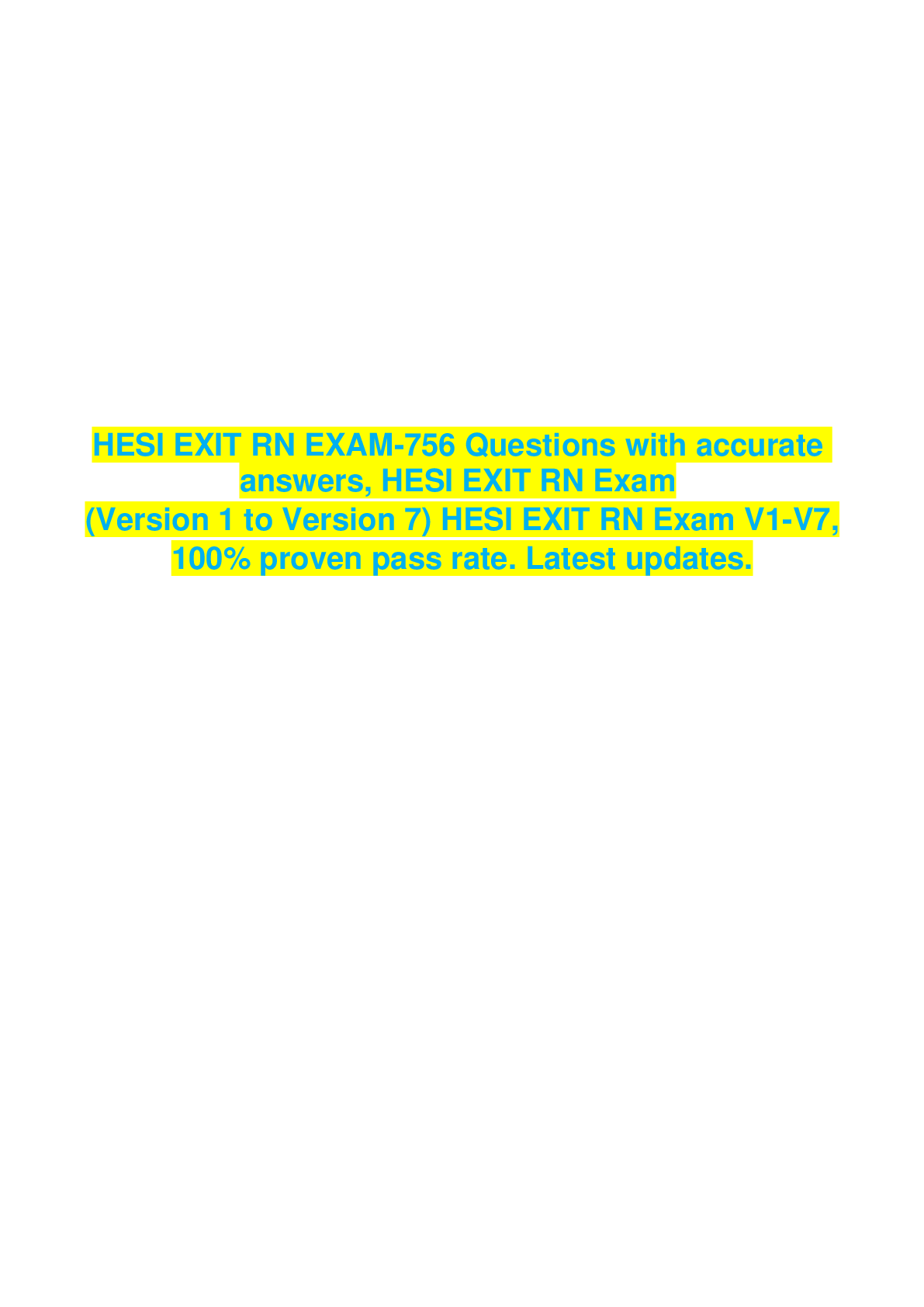
Reviews( 0 )
Document information
Connected school, study & course
About the document
Uploaded On
Oct 03, 2022
Number of pages
331
Written in
Additional information
This document has been written for:
Uploaded
Oct 03, 2022
Downloads
0
Views
355




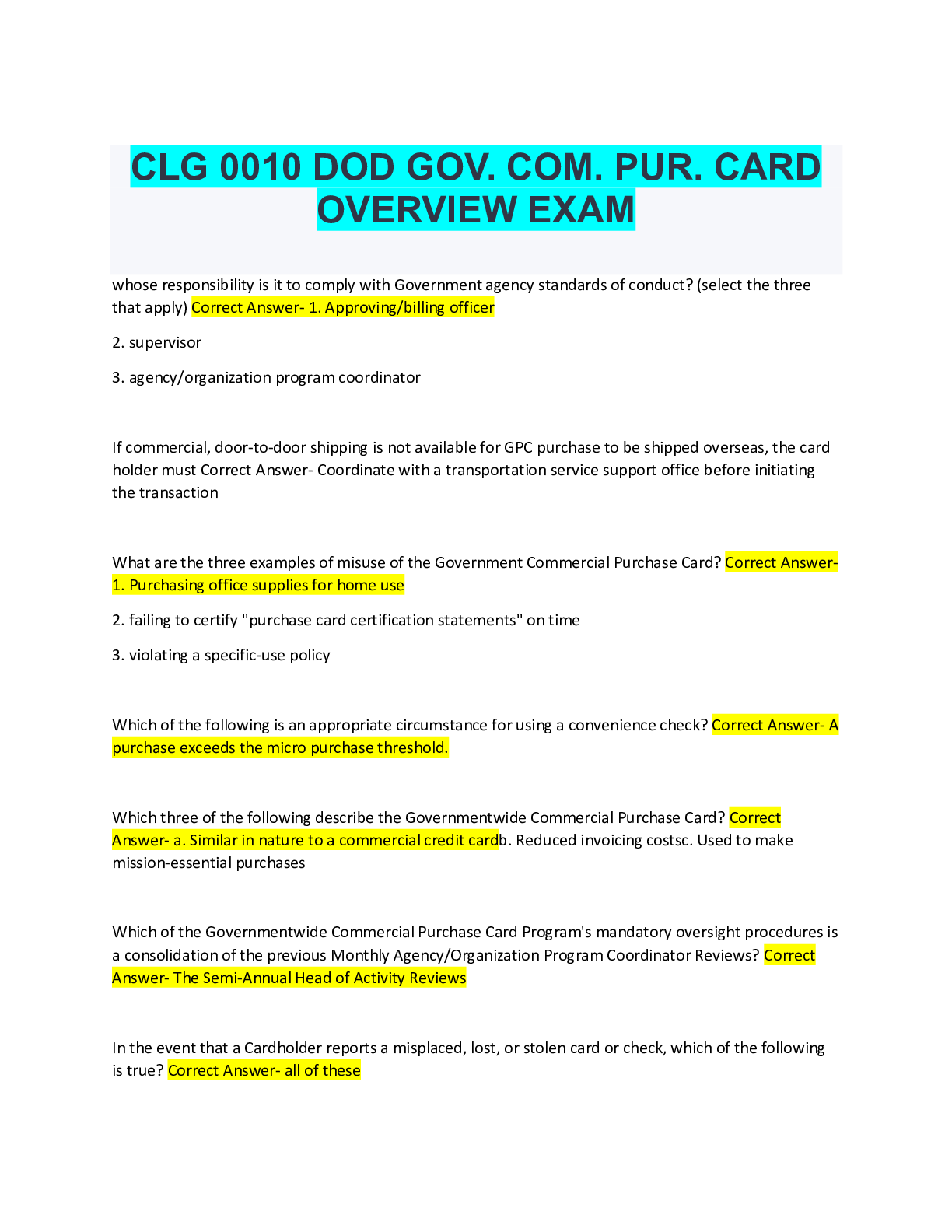


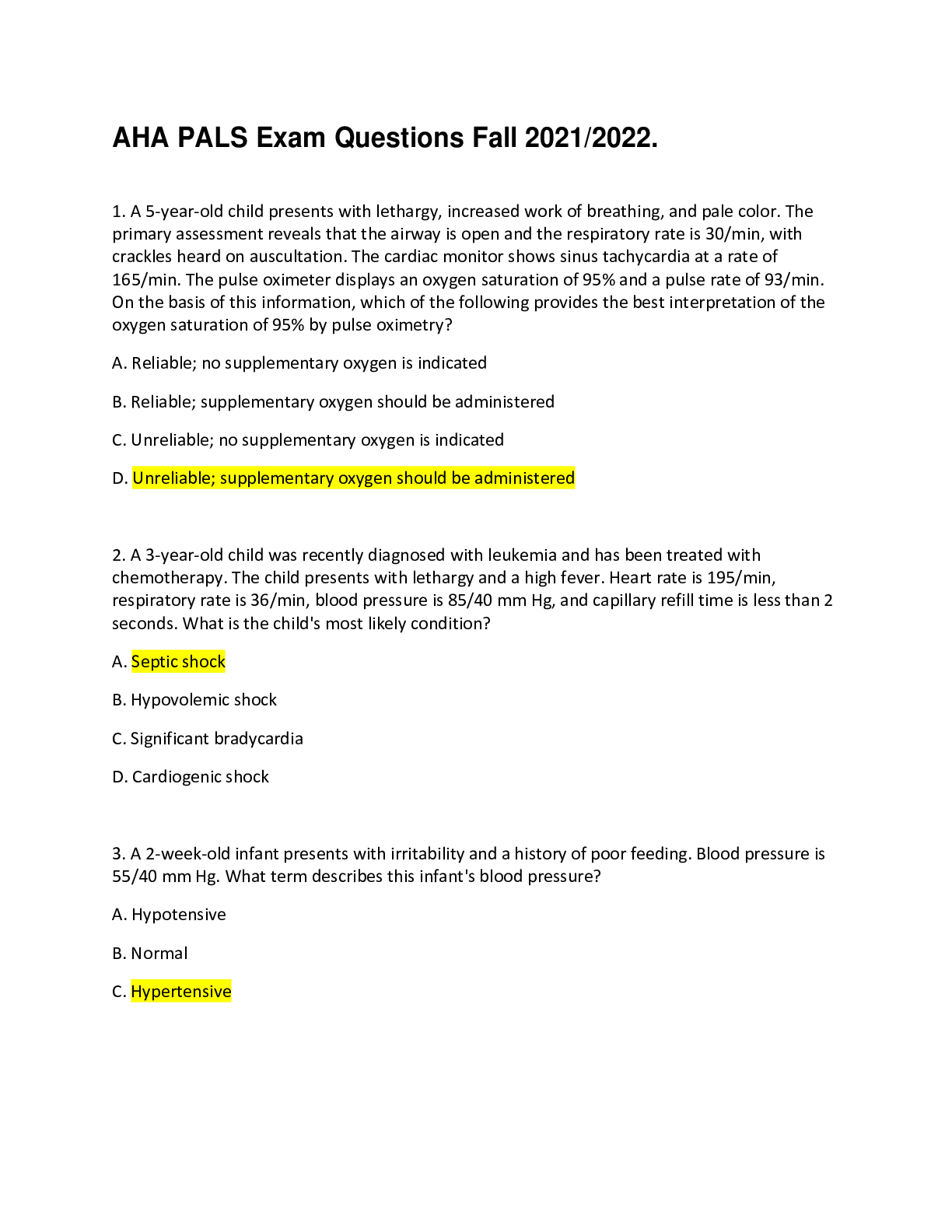

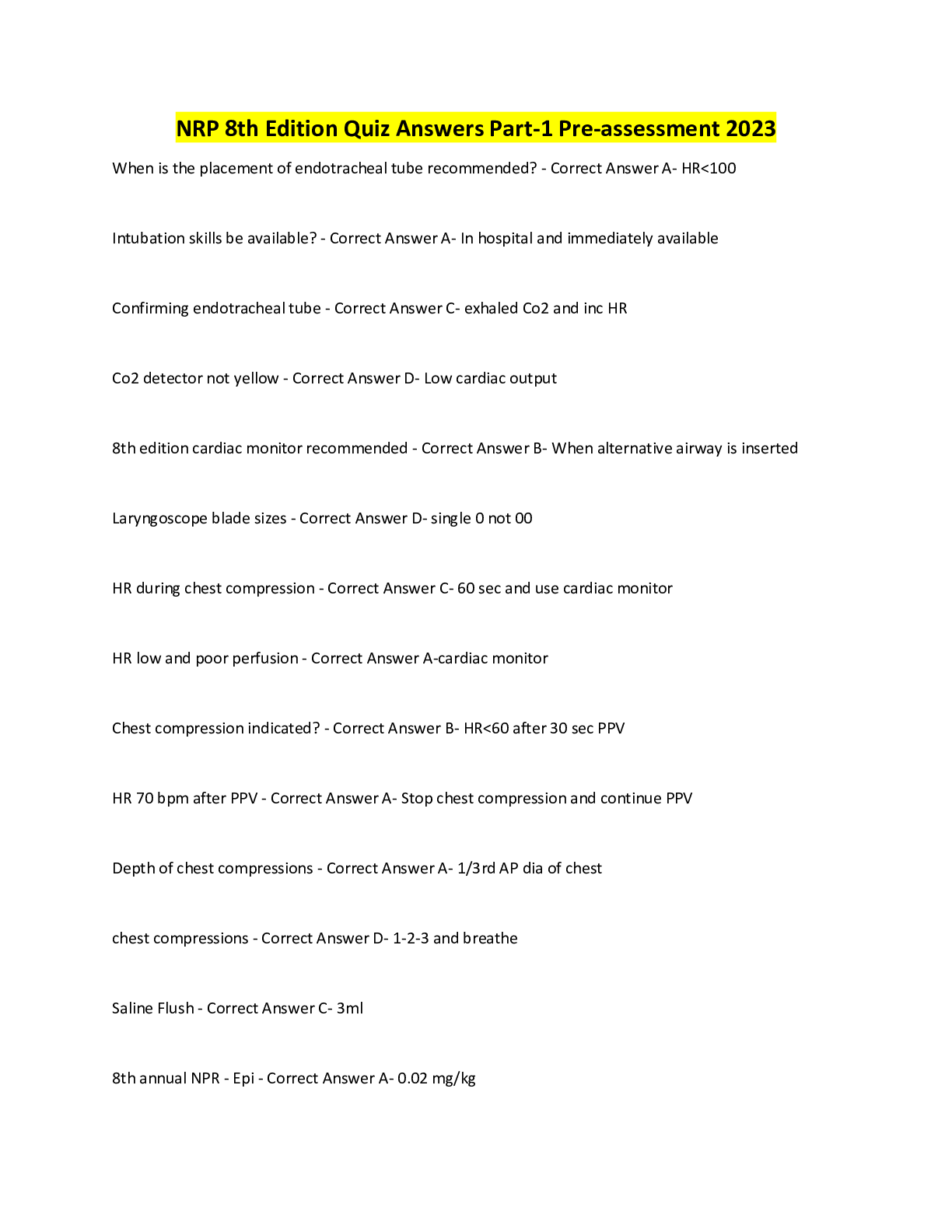

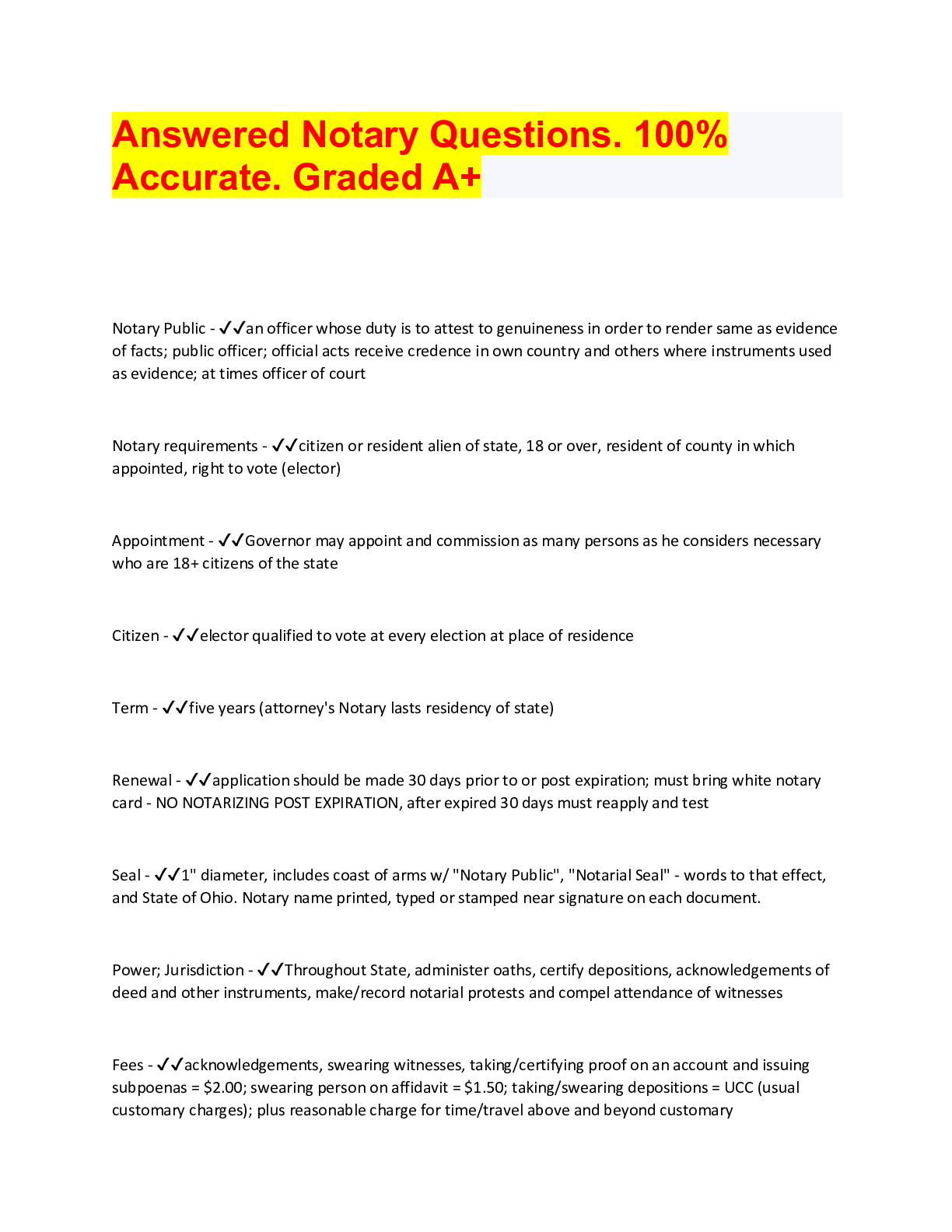

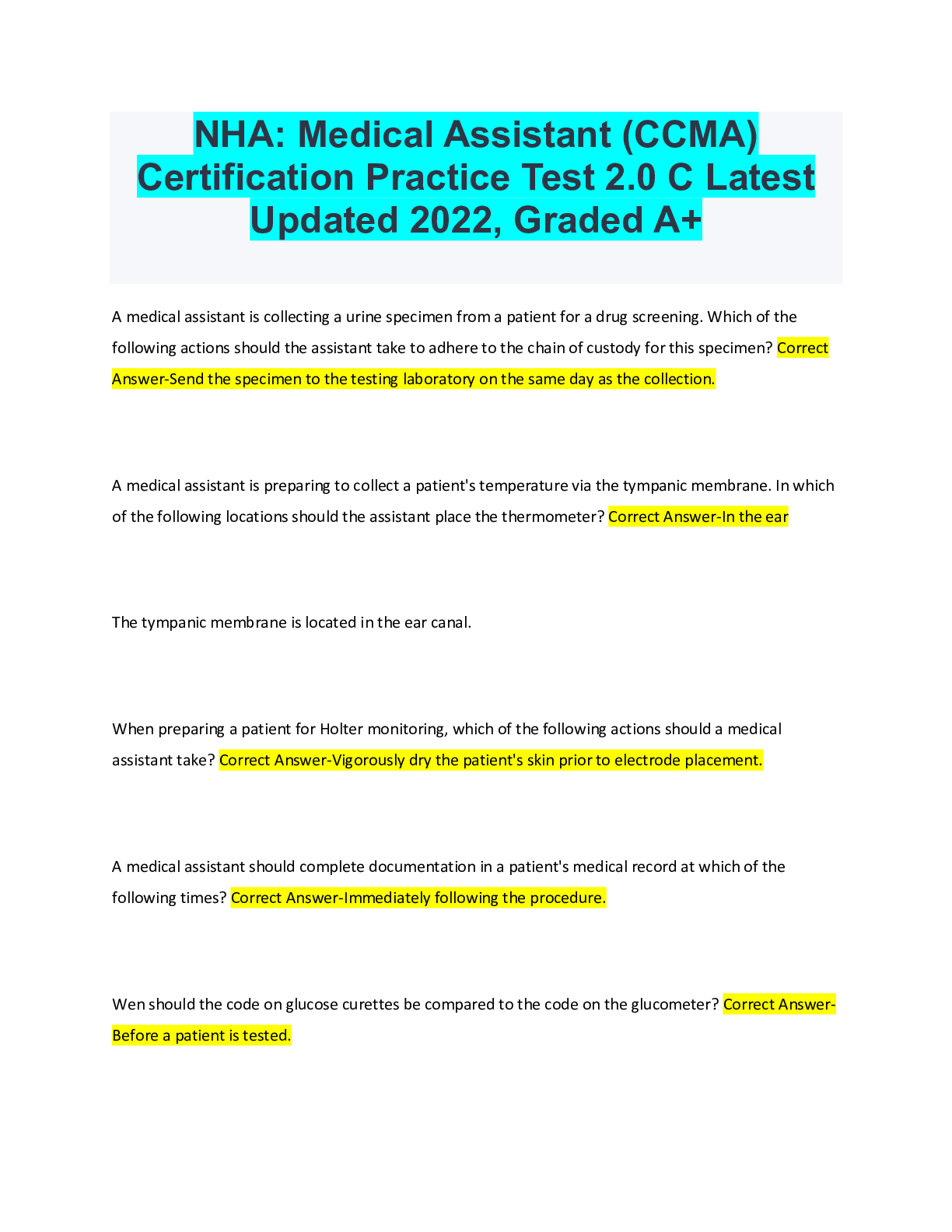
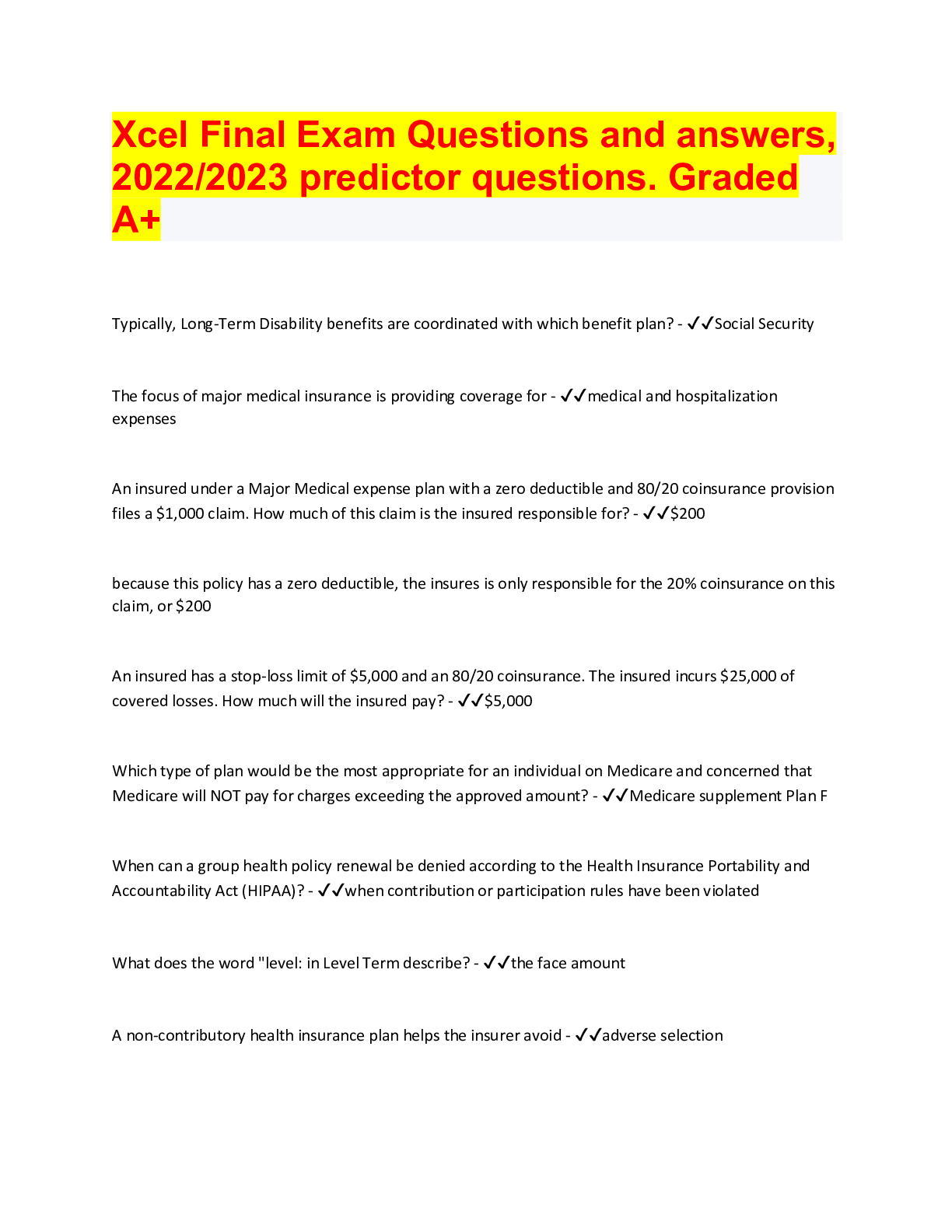
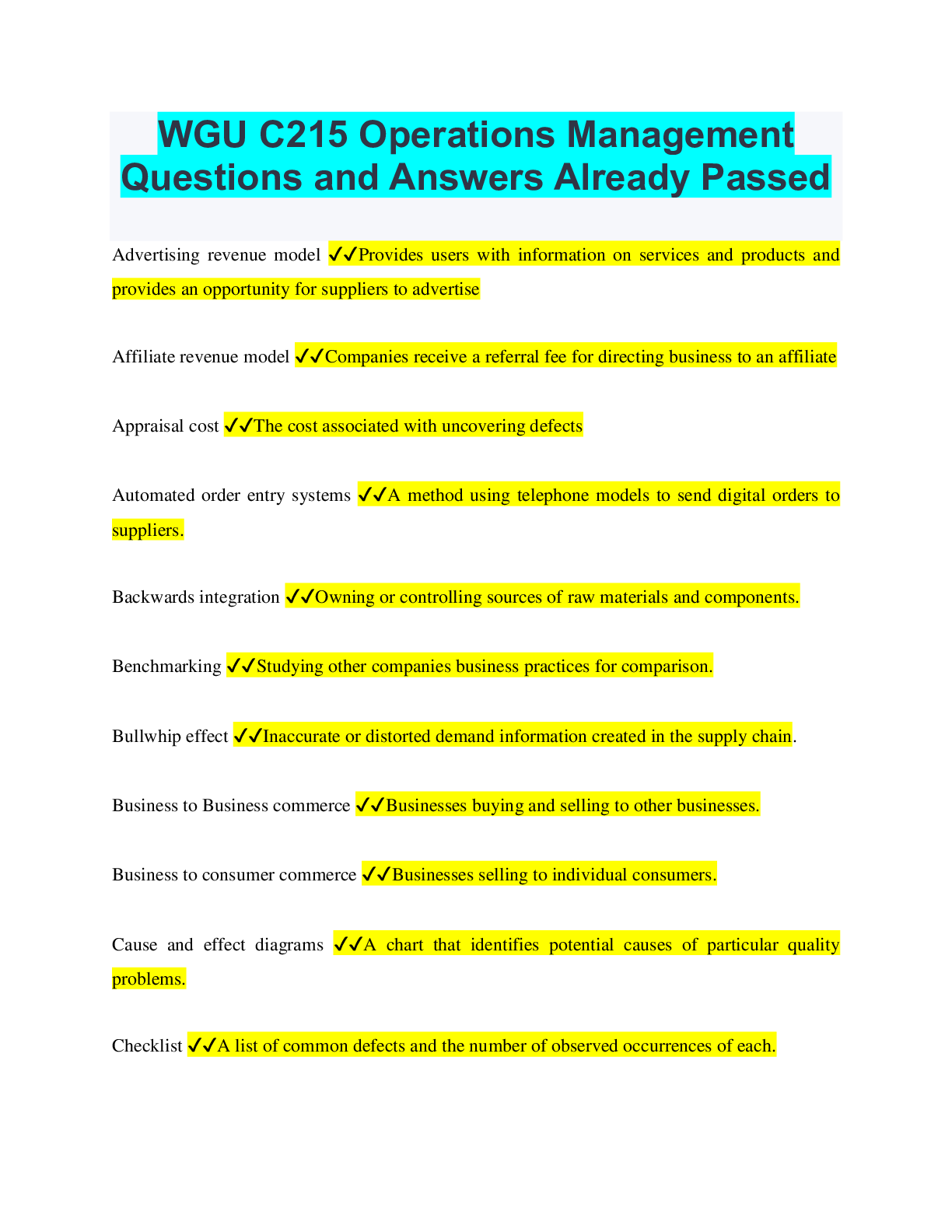
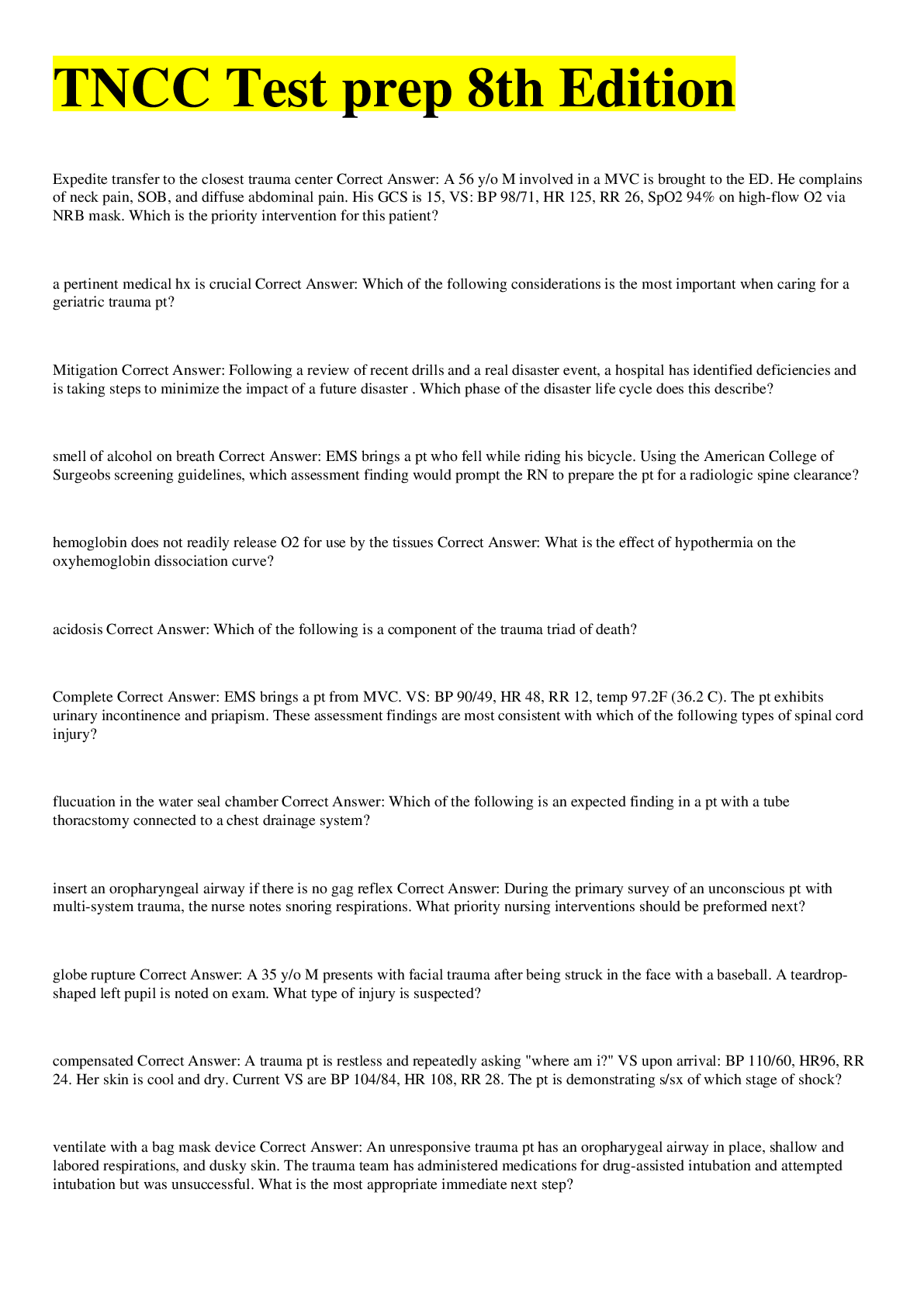
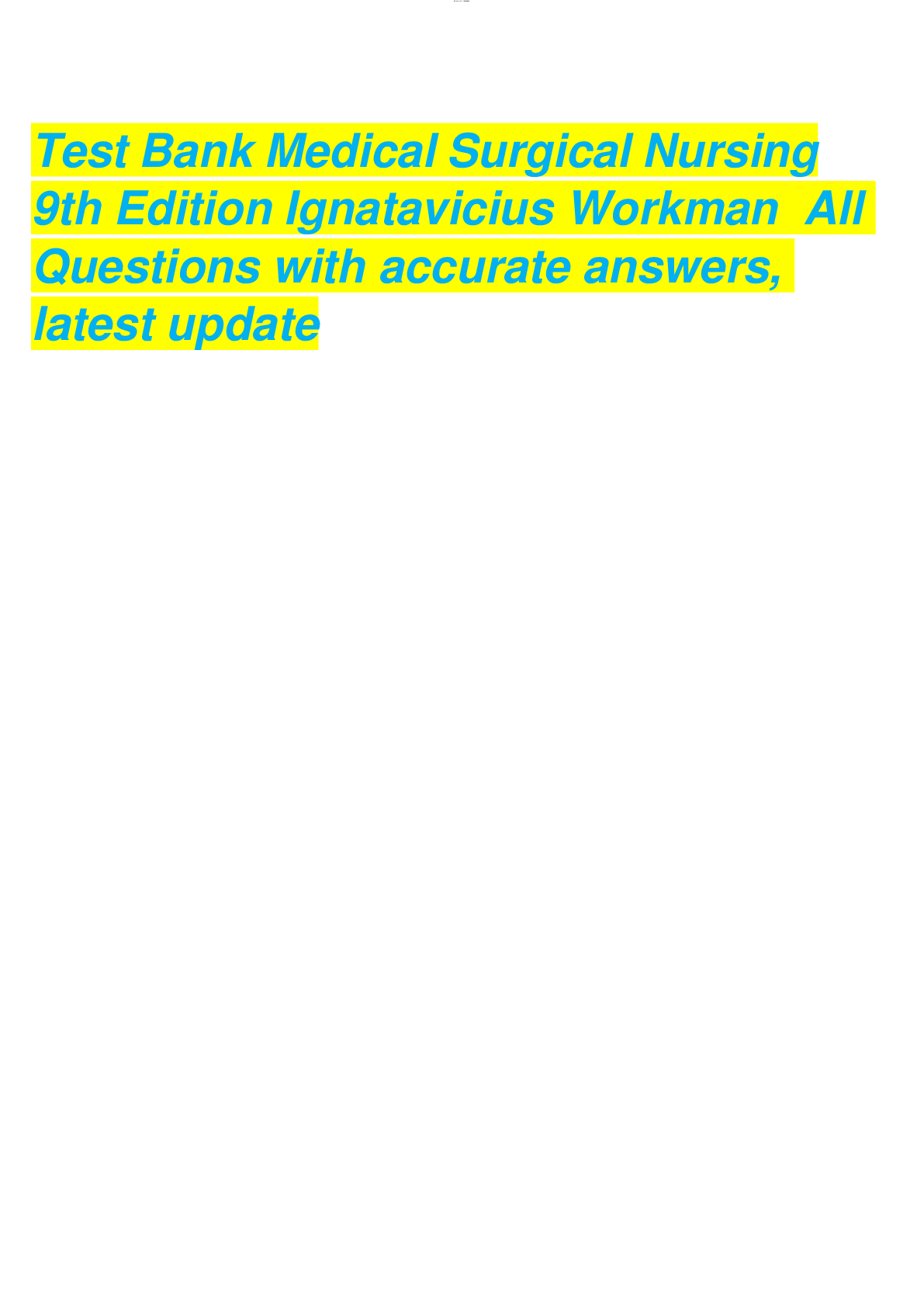
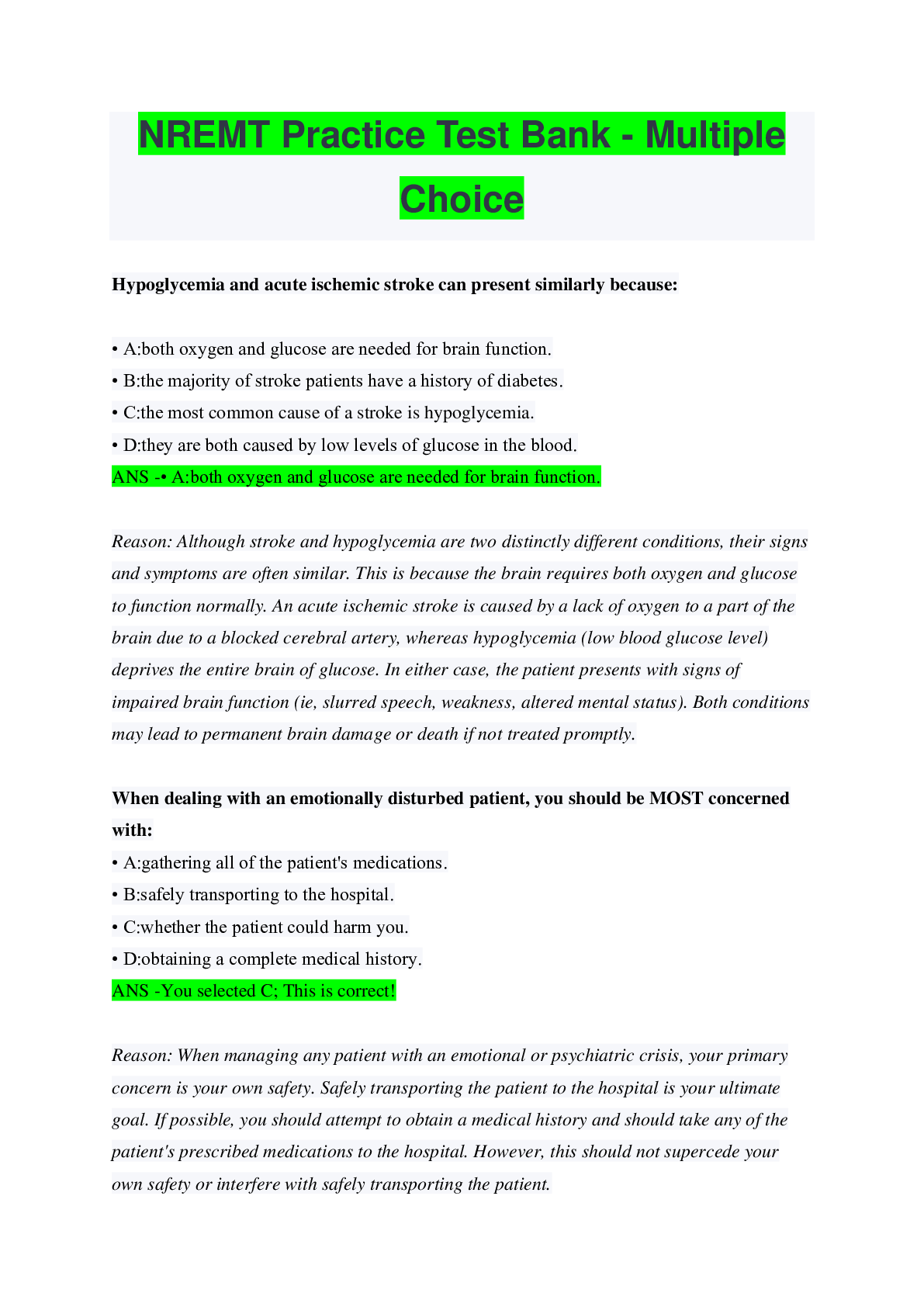
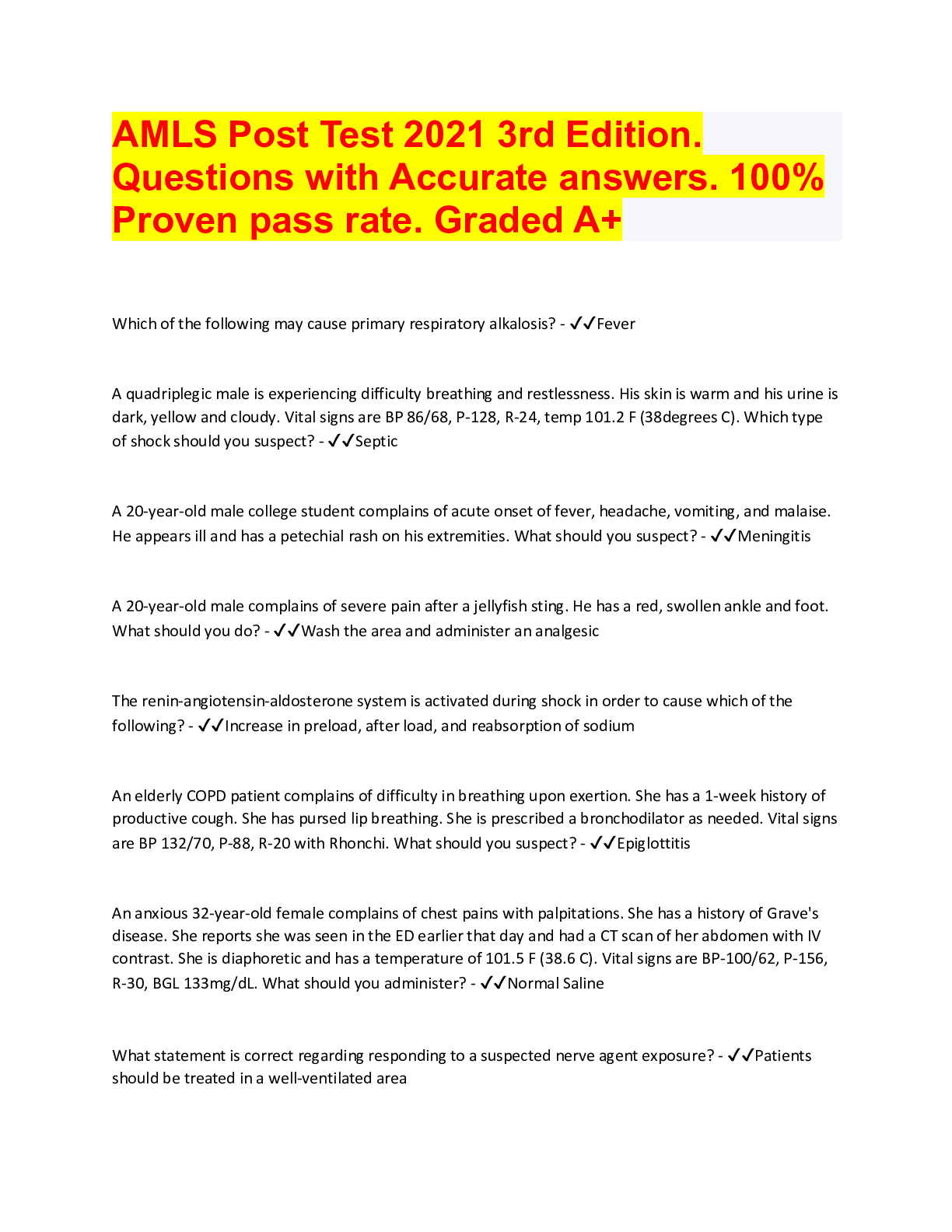
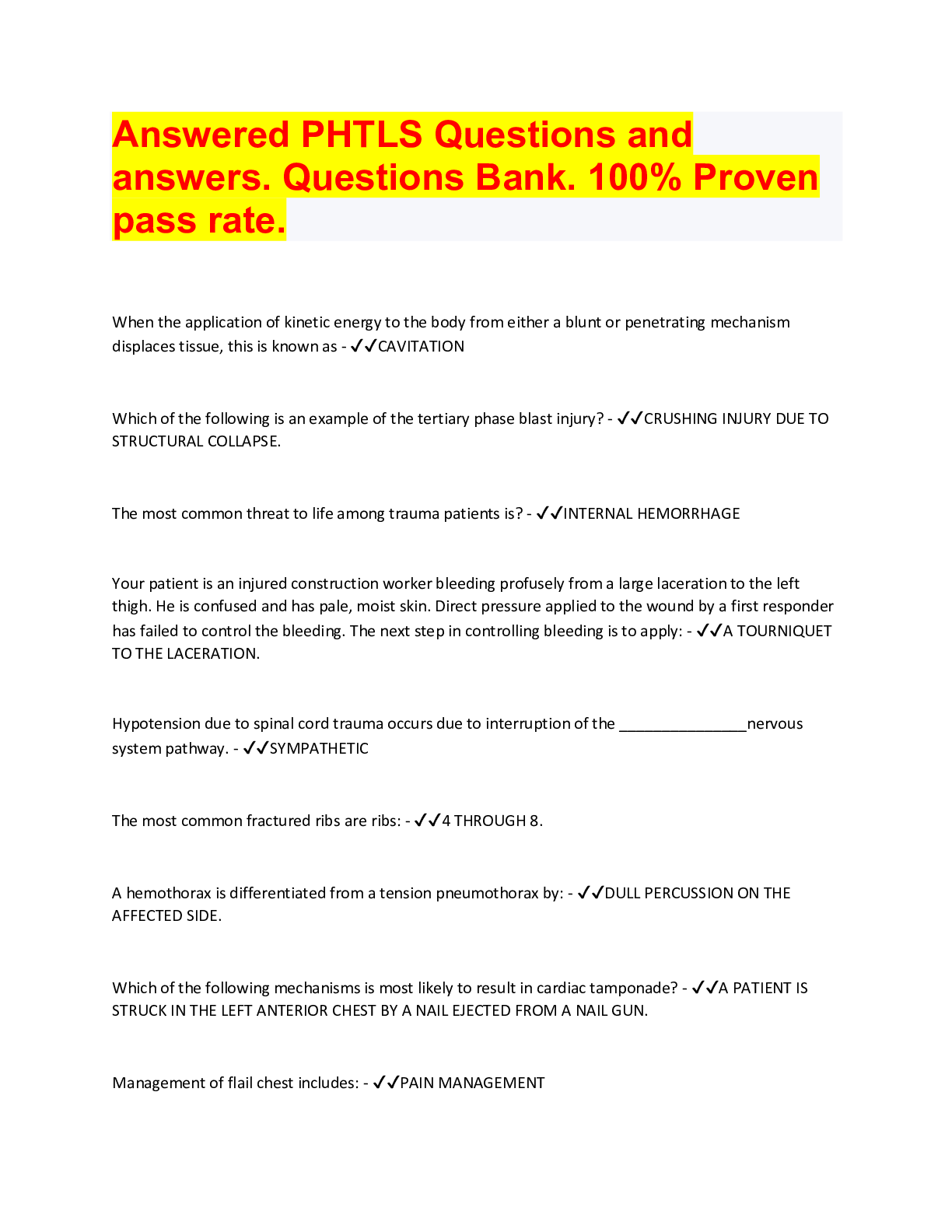
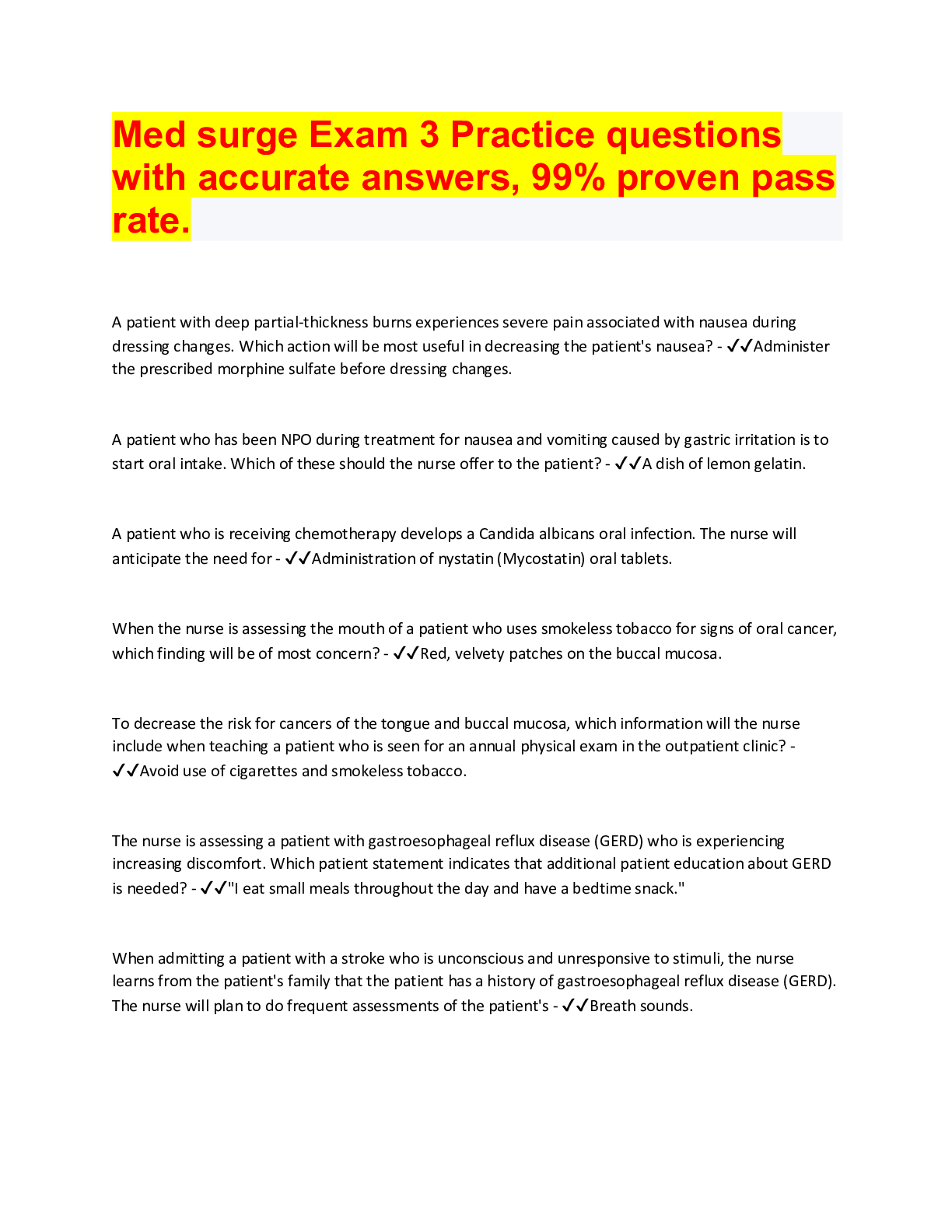
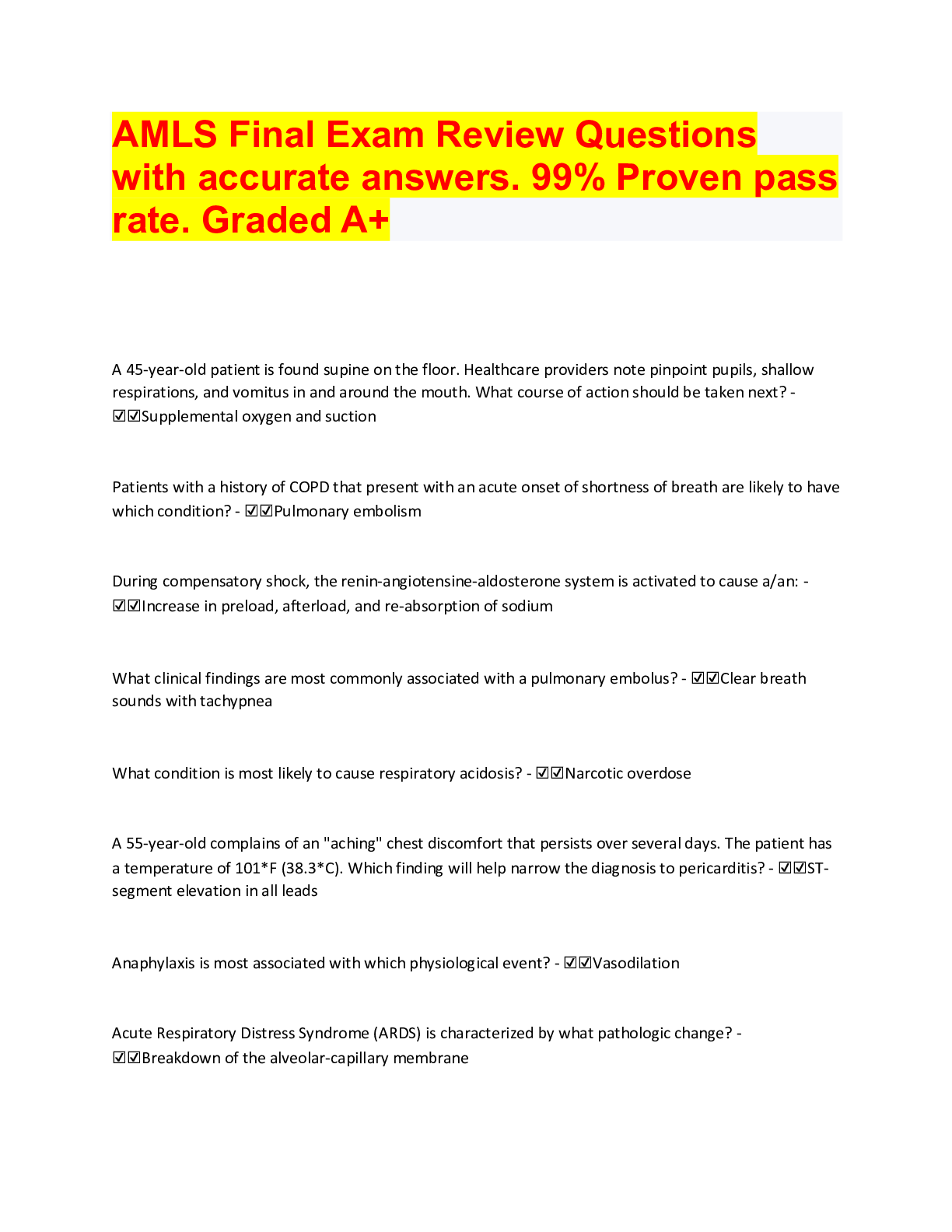
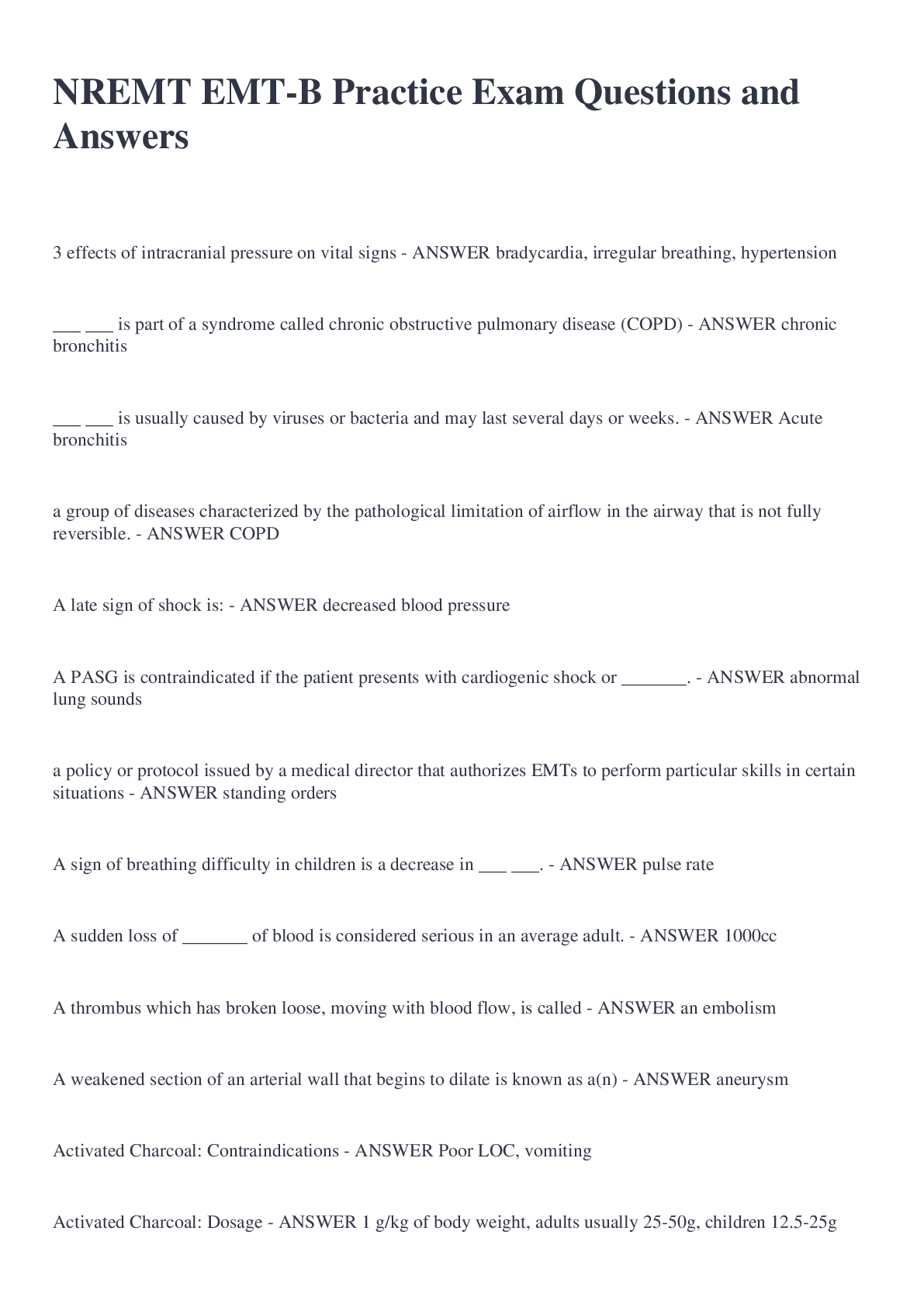
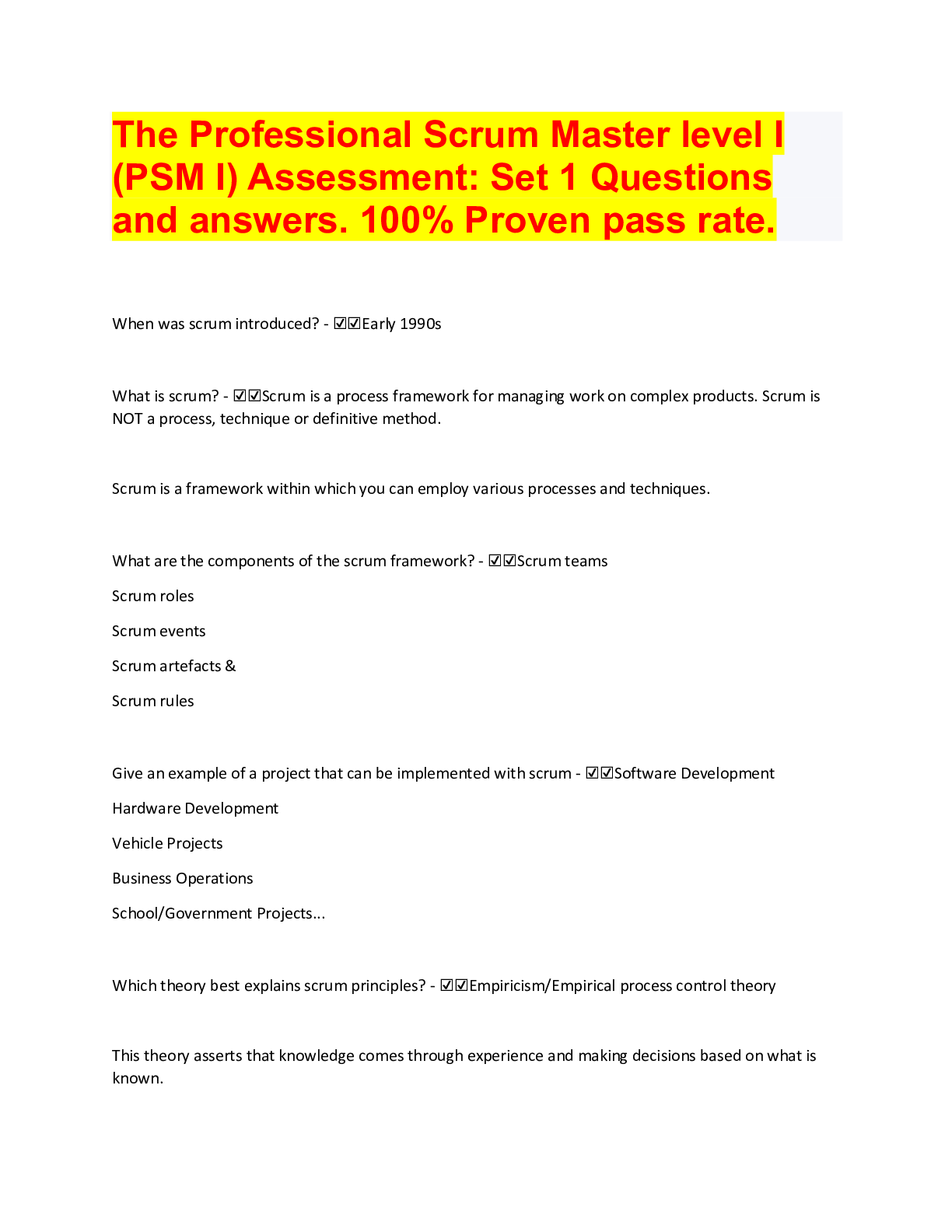
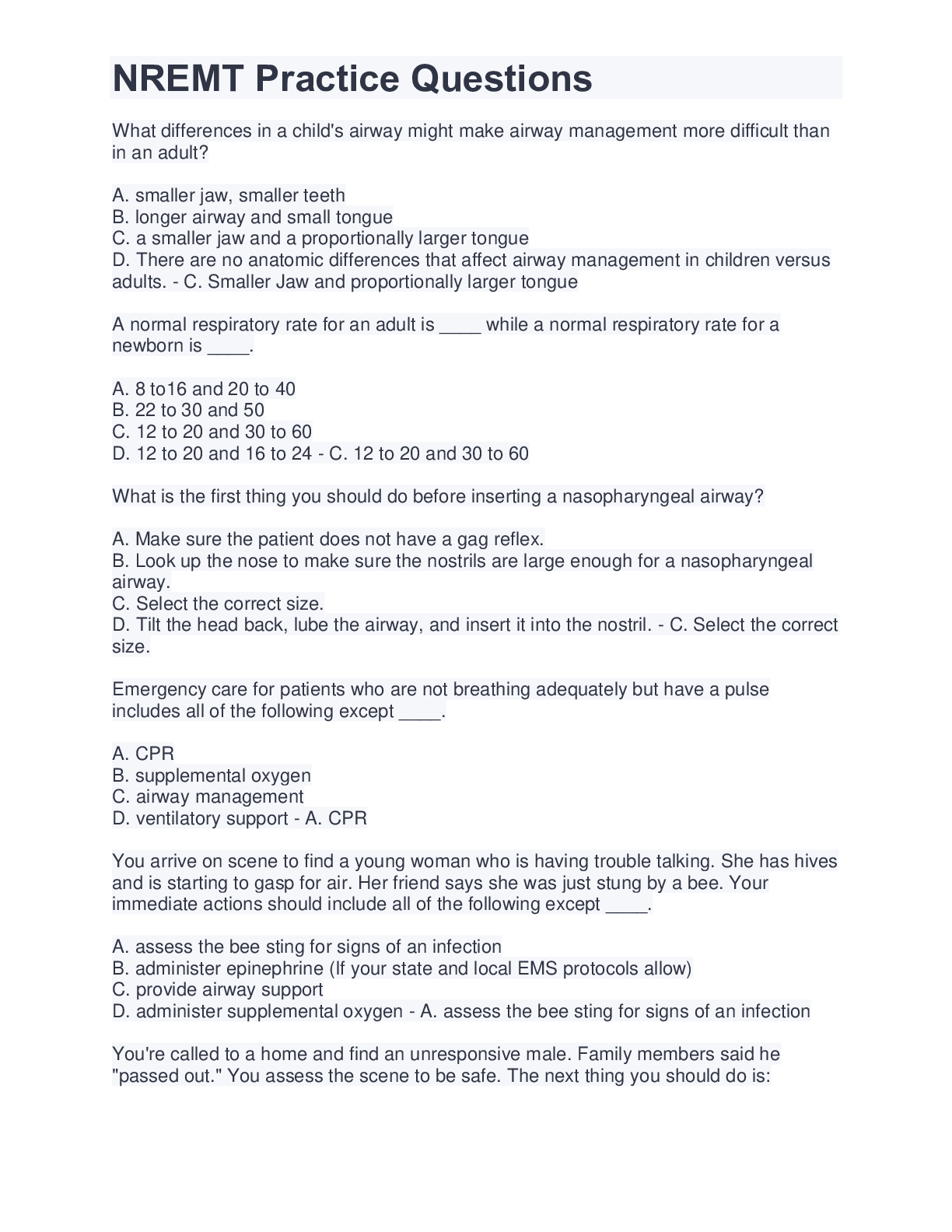
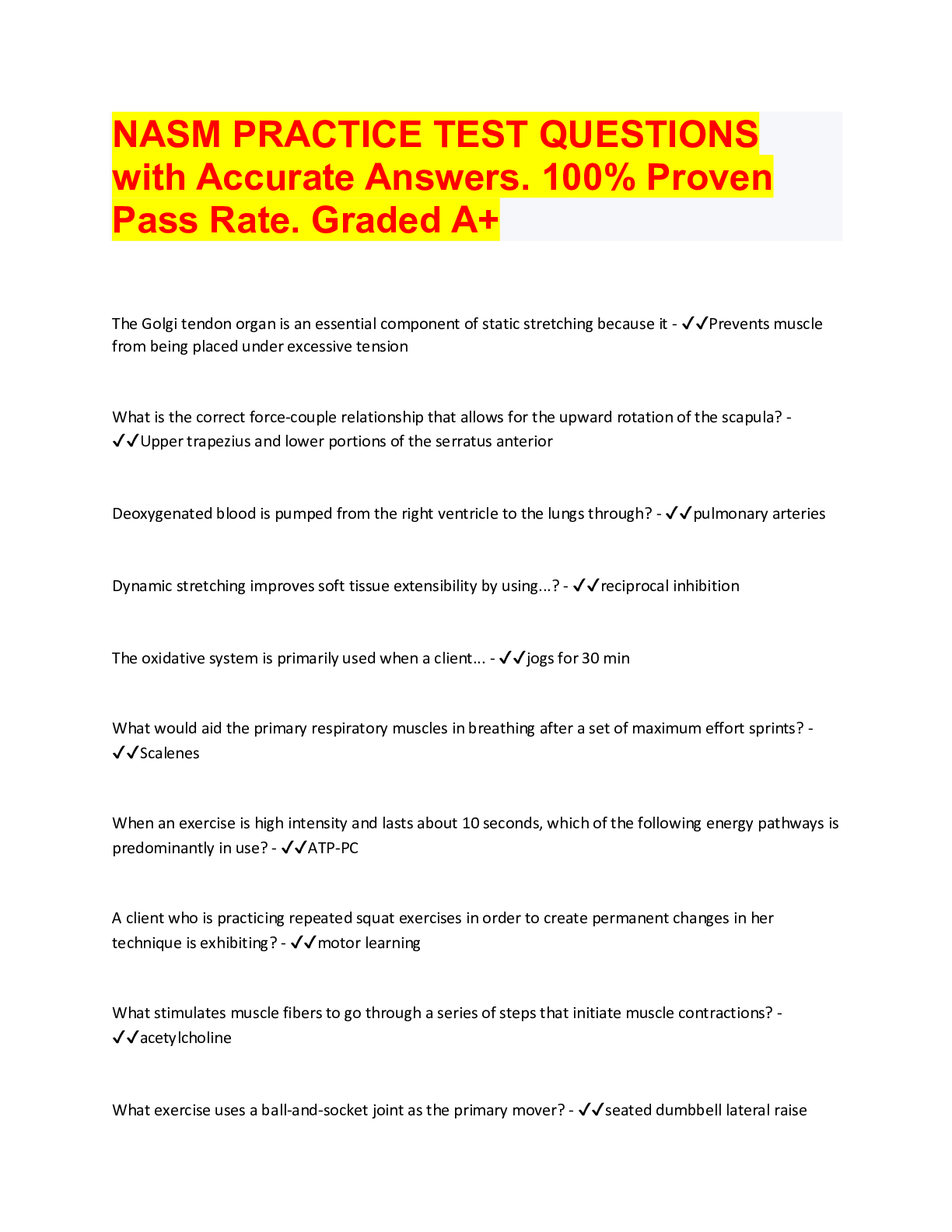
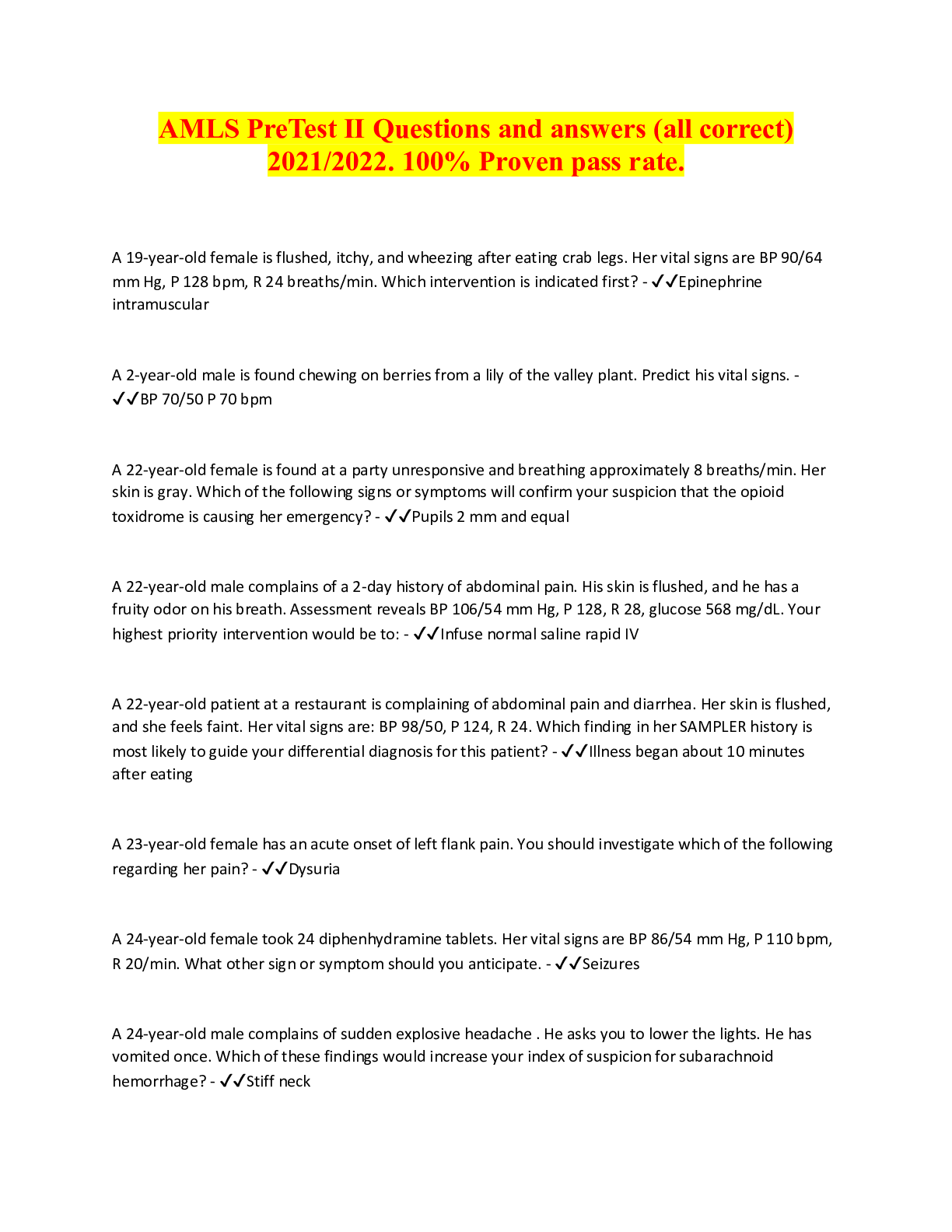
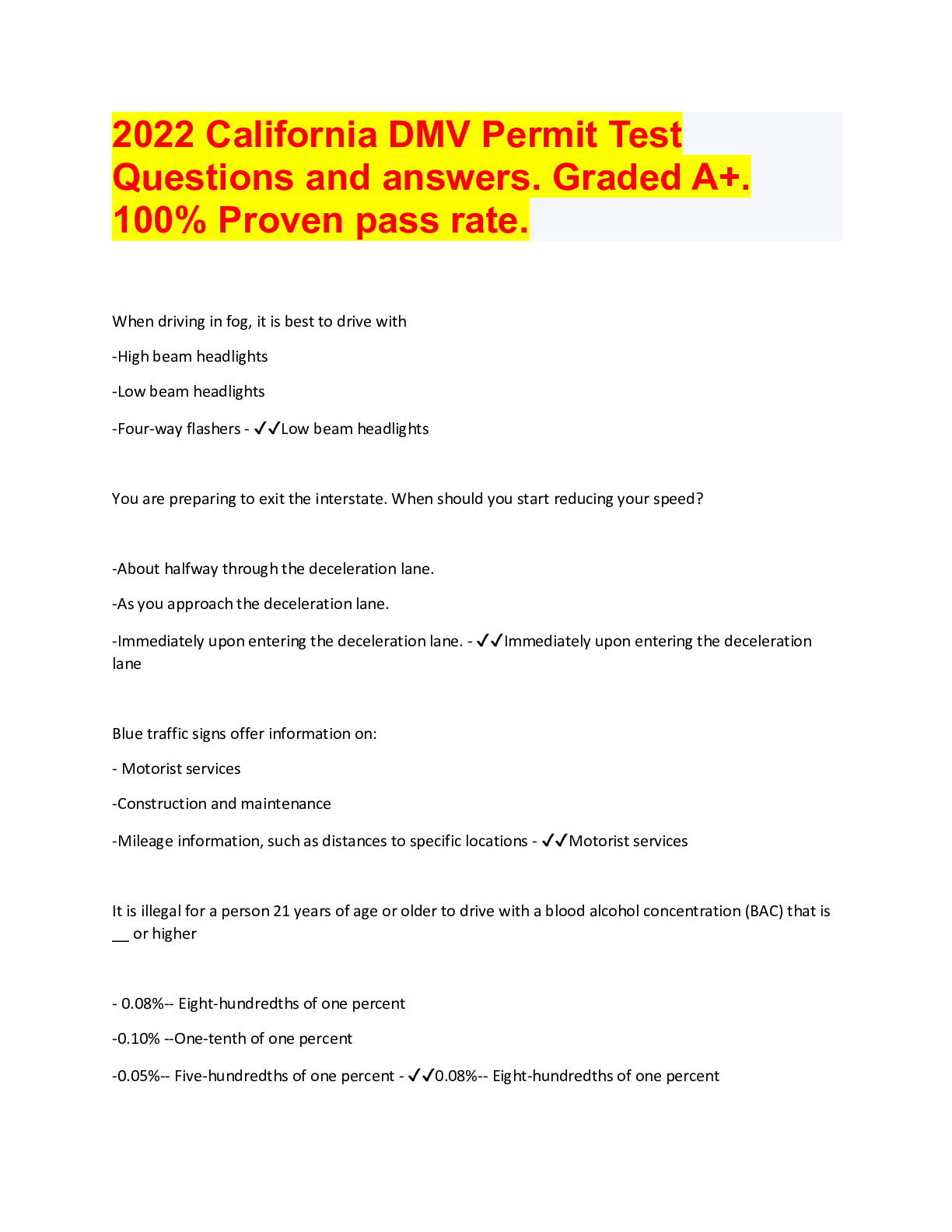
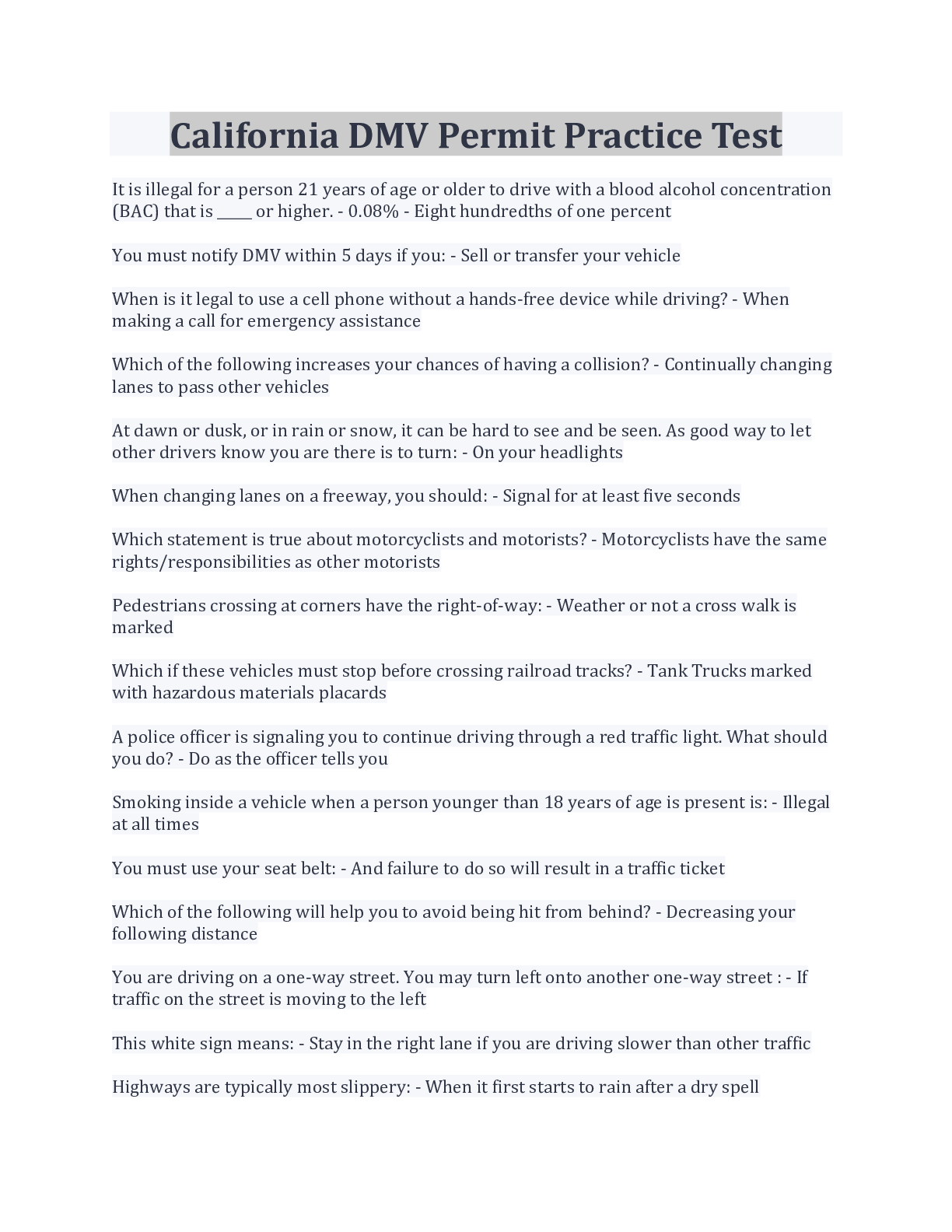
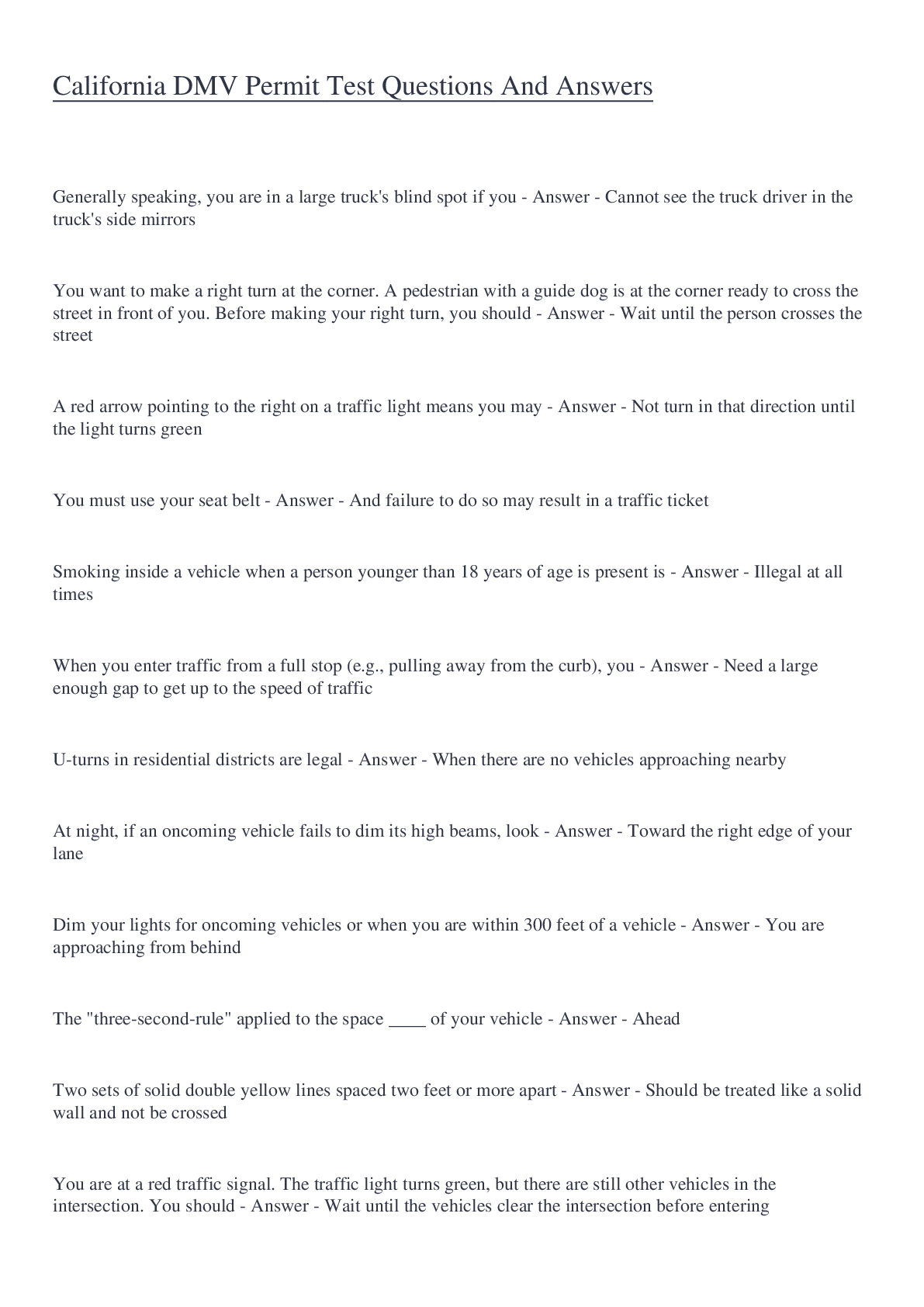

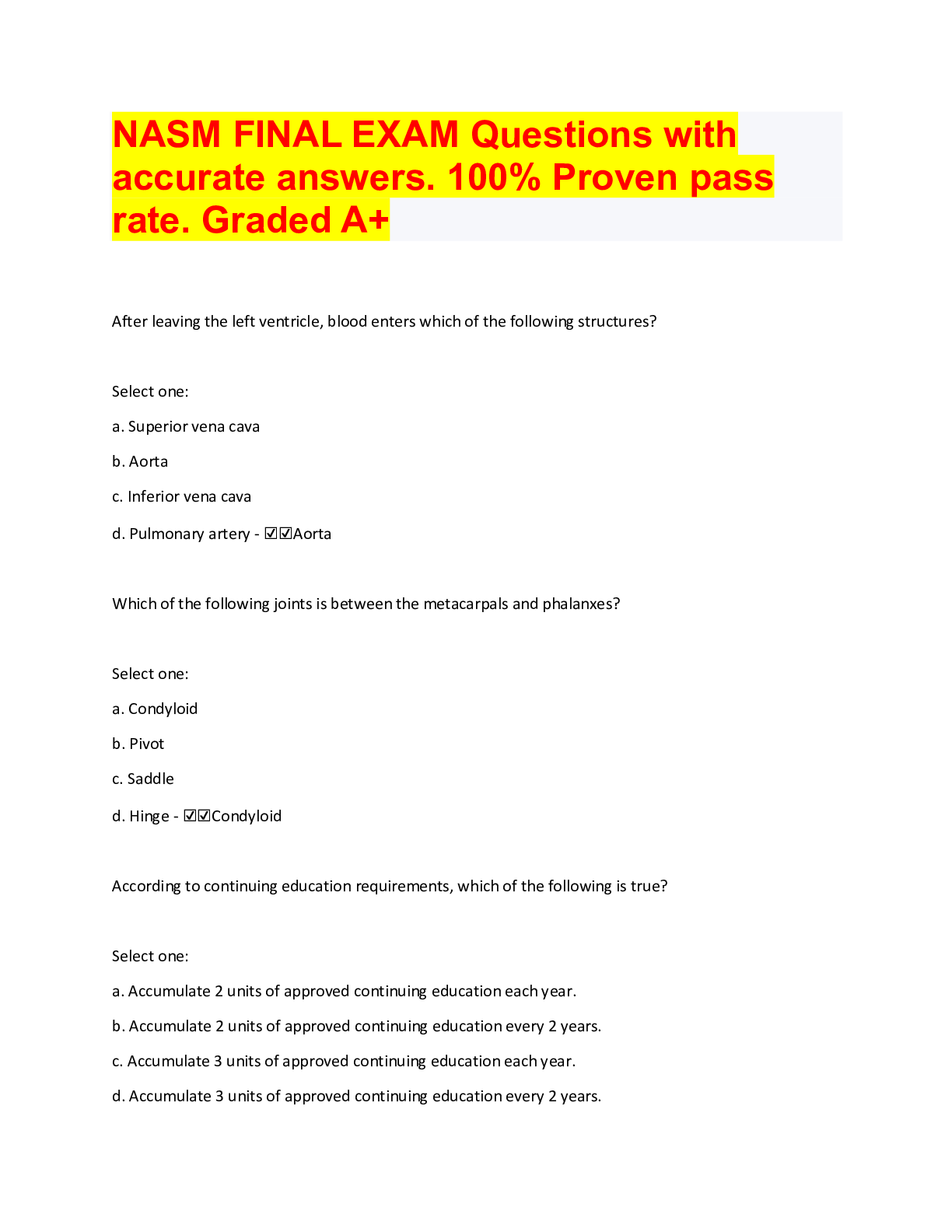
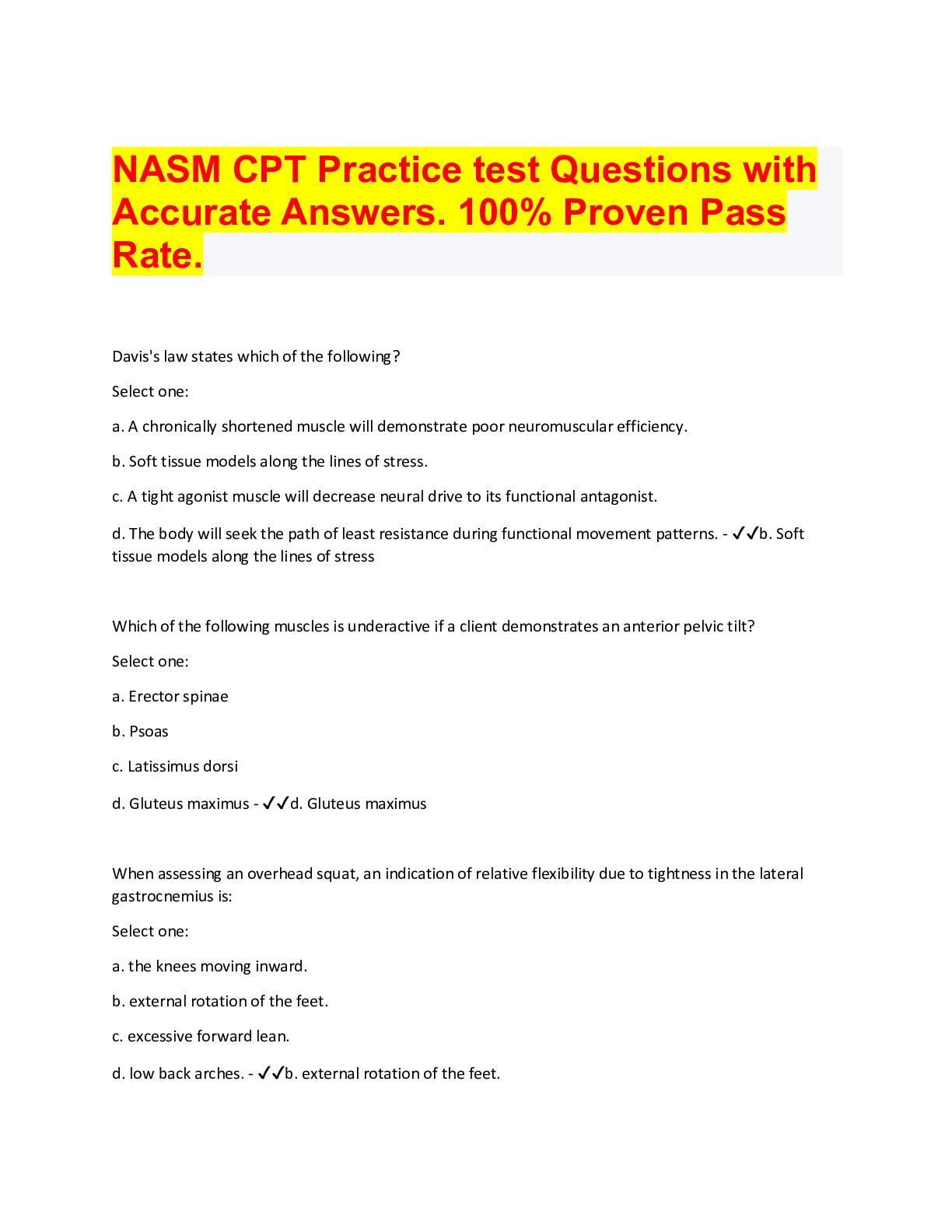
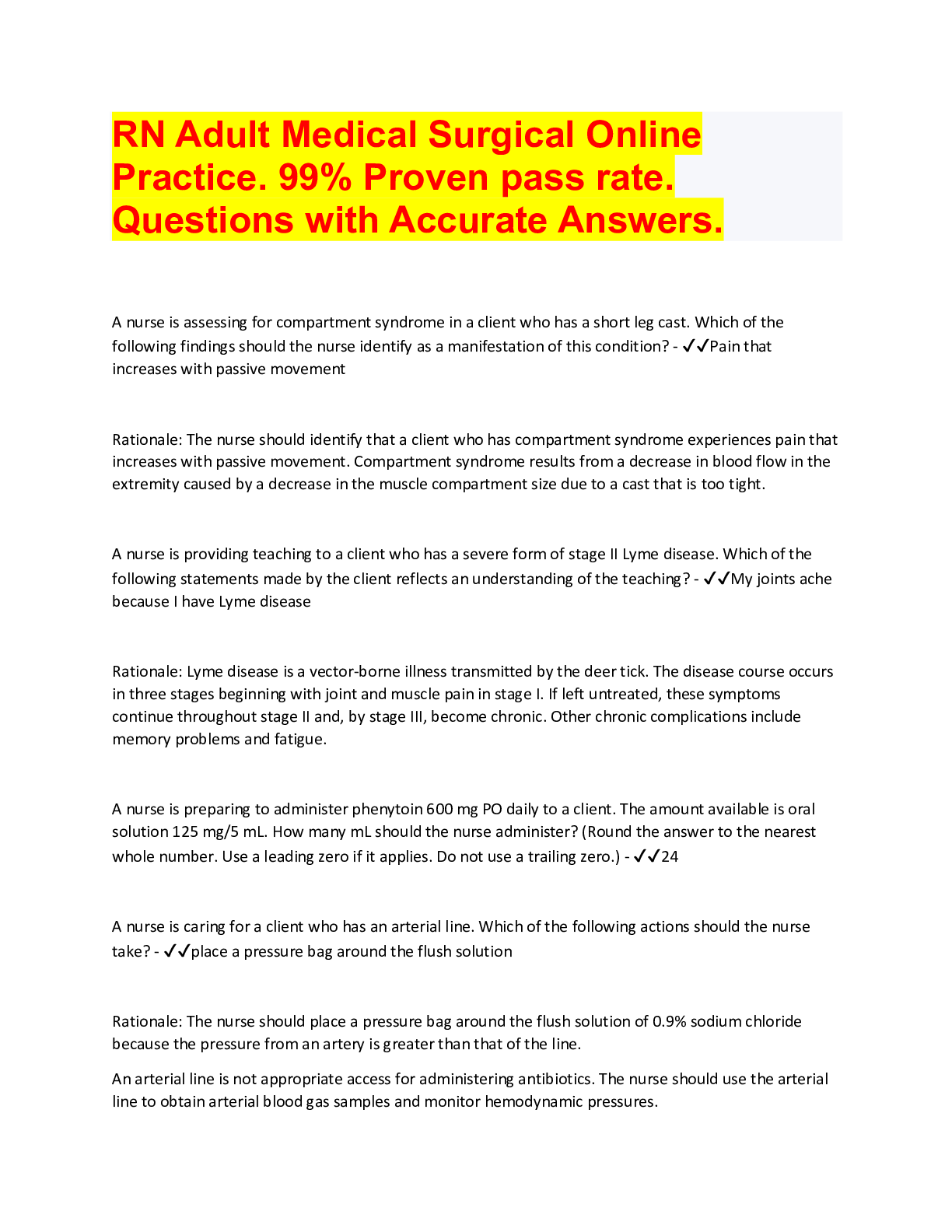
 110 OUT OF THE 160 TOTAL QUESTIONS FOR EACH VERSION AUTHENTIC Questions and Answers (latest Update), Correct, Download to Score A.png)

